运营管理课后习题答案
运营管理第6版习题与参考答案_第02章
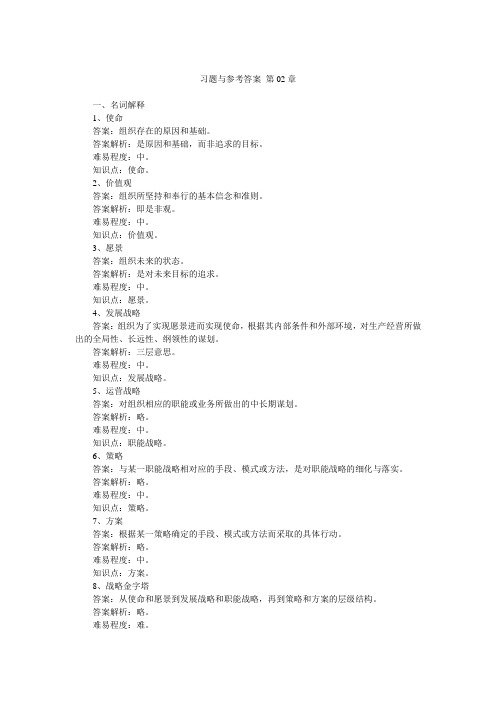
习题与参考答案_第02章一、名词解释1、使命答案:组织存在的原因和基础。
答案解析:是原因和基础,而非追求的目标。
难易程度:中。
知识点:使命。
2、价值观答案:组织所坚持和奉行的基本信念和准则。
答案解析:即是非观。
难易程度:中。
知识点:价值观。
3、愿景答案:组织未来的状态。
答案解析:是对未来目标的追求。
难易程度:中。
知识点:愿景。
4、发展战略答案:组织为了实现愿景进而实现使命,根据其内部条件和外部环境,对生产经营所做出的全局性、长远性、纲领性的谋划。
答案解析:三层意思。
难易程度:中。
知识点:发展战略。
5、运营战略答案:对组织相应的职能或业务所做出的中长期谋划。
答案解析:略。
难易程度:中。
知识点:职能战略。
6、策略答案:与某一职能战略相对应的手段、模式或方法,是对职能战略的细化与落实。
答案解析:略。
难易程度:中。
知识点:策略。
7、方案答案:根据某一策略确定的手段、模式或方法而采取的具体行动。
答案解析:略。
难易程度:中。
知识点:方案。
8、战略金字塔答案:从使命和愿景到发展战略和职能战略,再到策略和方案的层级结构。
答案解析:略。
难易程度:难。
知识点:战略金字塔。
9、SWOT分析答案:一种战略分析方法。
这种方法综合考虑企业内部条件与外部环境,通过构建组合矩阵进行战略选择。
答案解析:略。
难易程度:中。
知识点:SWOT分析。
10、波特五力模型答案:一种战略分析方法。
这种方法综合考虑来自行业竞争者、供应商、用户、替代品生产者、潜在进入者等5个方面的竞争压力进行战略选择。
答案解析:略。
难易程度:中。
知识点:波特五力模型。
11、BCG矩阵答案:一种战略分析方法。
这种方法从业务增长率和相对市场占有率两个维度对企业的业务进行分析,从而做出战略选择。
可增加两个维度,即营业收入所占比例和利润所占比例。
答案解析:略。
难易程度:中。
知识点:BCG矩阵。
12、平衡计分卡答案:一种把使命、愿景和战略转换为实际行动的有效方法。
这种方法实现了从一个纯粹的财务角度转变为与其他方面进行整合,把财务、顾客、内部业务流程和学习与成长整合在一起,从过去和未来两大视角,用四个维度来平衡财务绩效与非财务绩效,外部绩效与内部绩效。
第12版运营管理习题答案
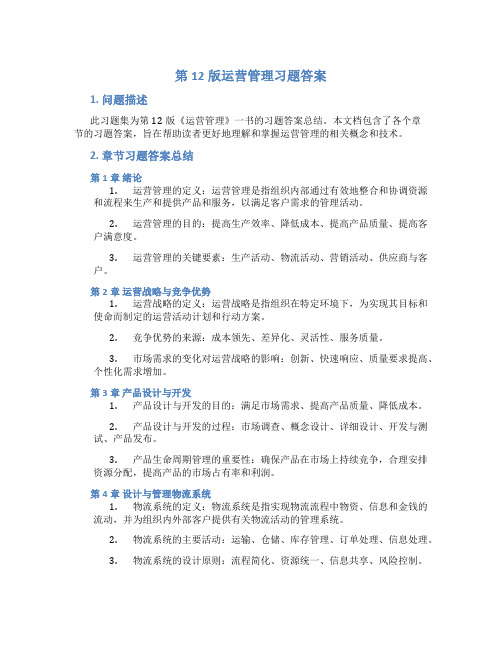
第12版运营管理习题答案1. 问题描述此习题集为第12版《运营管理》一书的习题答案总结。
本文档包含了各个章节的习题答案,旨在帮助读者更好地理解和掌握运营管理的相关概念和技术。
2. 章节习题答案总结第1章绪论1.运营管理的定义:运营管理是指组织内部通过有效地整合和协调资源和流程来生产和提供产品和服务,以满足客户需求的管理活动。
2.运营管理的目的:提高生产效率、降低成本、提高产品质量、提高客户满意度。
3.运营管理的关键要素:生产活动、物流活动、营销活动、供应商与客户。
第2章运营战略与竞争优势1.运营战略的定义:运营战略是指组织在特定环境下,为实现其目标和使命而制定的运营活动计划和行动方案。
2.竞争优势的来源:成本领先、差异化、灵活性、服务质量。
3.市场需求的变化对运营战略的影响:创新、快速响应、质量要求提高、个性化需求增加。
第3章产品设计与开发1.产品设计与开发的目的:满足市场需求、提高产品质量、降低成本。
2.产品设计与开发的过程:市场调查、概念设计、详细设计、开发与测试、产品发布。
3.产品生命周期管理的重要性:确保产品在市场上持续竞争,合理安排资源分配,提高产品的市场占有率和利润。
第4章设计与管理物流系统1.物流系统的定义:物流系统是指实现物流流程中物资、信息和金钱的流动,并为组织内外部客户提供有关物流活动的管理系统。
2.物流系统的主要活动:运输、仓储、库存管理、订单处理、信息处理。
3.物流系统的设计原则:流程简化、资源统一、信息共享、风险控制。
第5章质量管理1.质量管理的定义:质量管理是指通过制定和实施一系列的管理活动,以提高产品和服务的质量、满足客户需求的管理过程。
2.质量管理的工具:质量控制图、散点图、直方图、因果图、帕累托图、流程图等。
3.质量成本的分类:预防成本、评估成本、内部失败成本、外部失败成本。
第6章运营系统的布局与设计1.运营系统布局与设计的目的:提高资源利用率、降低库存成本、减少物料搬运。
运营管理概论习题与答案(运营管理)
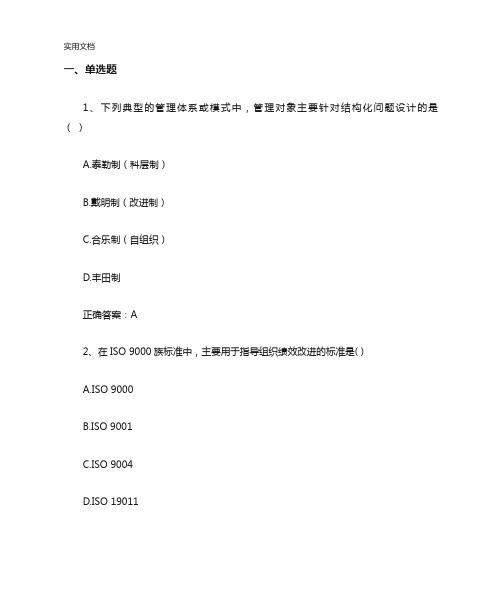
一、单选题1、下列典型的管理体系或模式中,管理对象主要针对结构化问题设计的是()A.泰勒制(科层制)B.戴明制(改进制)C.合乐制(自组织)D.丰田制正确答案:A2、在ISO 9000族标准中,主要用于指导组织绩效改进的标准是( )A.ISO 9000B.ISO 9001C.ISO 9004D.ISO 19011正确答案:C3、当前企业经营管理面临的环境可以简要地概括为()A.“3C”+知识经济+交互网络+AIB.社会环境+经济环境C.市场经济+法制社会D.人工智能+互联网+大数据正确答案:A4、泰勒制或“科学管理”的关键活动是()A.领导B.监视与控制C.效率D.质量正确答案:B5、基于事实的决策意味着()A.根据数据决策B.根据数量分析决策C.根据事实的分析、经验和直觉决策D.基于真理决策正确答案:C二、多选题1、全面质量管理的原则包括()A.以顾客为关注焦点B.领导作用C.全员参与D.统计过程控制(SPC)正确答案:A、B、C2、运营管理的主要挑战涉及()A.信息技术的冲击B.环保要求、伦理标准C.多元化的新员工D.全球化正确答案:A、B、C、D3、在顾客居于主导地位、激烈竞争与快速变化的环境中,企业生存与发展关键在于()A.快速B.灵活、柔性、敏捷C.持续改进与创新D.对人的严密控制正确答案:A、B、C4、下列属于快餐连锁店中典型的运营活动的有( )A.选择潜在餐厅地点B.维修食品加工设备C.提供制作汉堡的程序D.投放广告和宣传品正确答案:A、B、C5、美国的《卓越绩效准则》所描述的管理模式中,其基本过程包括()A.领导与战略B.人力资源与过程C.顾客和市场D.测量、分析与知识管理正确答案:A、B、C、D三、填空题1、过程的五个基本构成部分是:输入、转化活动、输出、监控、__________。
正确答案:方法2、质量定义为满足要求的__________。
正确答案:程度3、一百年来管理实践证明成功的管理是__________方法。
运营管理的课后习题答案
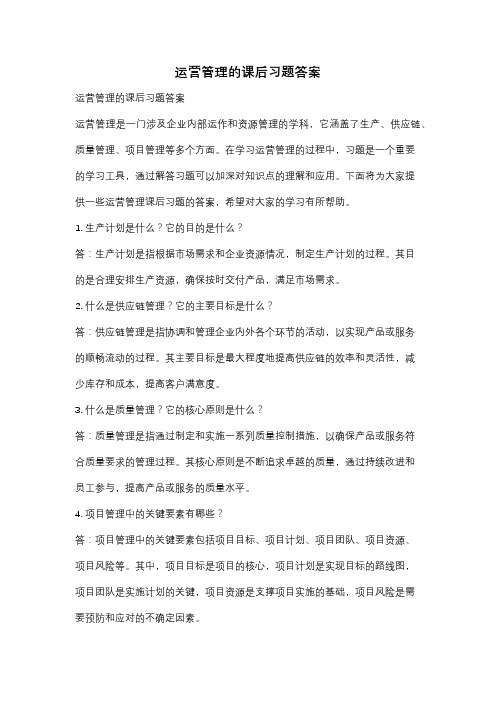
运营管理的课后习题答案运营管理的课后习题答案运营管理是一门涉及企业内部运作和资源管理的学科,它涵盖了生产、供应链、质量管理、项目管理等多个方面。
在学习运营管理的过程中,习题是一个重要的学习工具,通过解答习题可以加深对知识点的理解和应用。
下面将为大家提供一些运营管理课后习题的答案,希望对大家的学习有所帮助。
1. 生产计划是什么?它的目的是什么?答:生产计划是指根据市场需求和企业资源情况,制定生产计划的过程。
其目的是合理安排生产资源,确保按时交付产品,满足市场需求。
2. 什么是供应链管理?它的主要目标是什么?答:供应链管理是指协调和管理企业内外各个环节的活动,以实现产品或服务的顺畅流动的过程。
其主要目标是最大程度地提高供应链的效率和灵活性,减少库存和成本,提高客户满意度。
3. 什么是质量管理?它的核心原则是什么?答:质量管理是指通过制定和实施一系列质量控制措施,以确保产品或服务符合质量要求的管理过程。
其核心原则是不断追求卓越的质量,通过持续改进和员工参与,提高产品或服务的质量水平。
4. 项目管理中的关键要素有哪些?答:项目管理中的关键要素包括项目目标、项目计划、项目团队、项目资源、项目风险等。
其中,项目目标是项目的核心,项目计划是实现目标的路线图,项目团队是实施计划的关键,项目资源是支撑项目实施的基础,项目风险是需要预防和应对的不确定因素。
5. 什么是供应商评估?为什么要进行供应商评估?答:供应商评估是对供应商进行综合评价和筛选的过程。
其目的是确保选择到合适的供应商,以保证采购的品质和效益。
供应商评估可以帮助企业降低采购风险,提高供应链的稳定性和效率。
6. 什么是成本管理?成本管理的方法有哪些?答:成本管理是指对企业生产和运营过程中产生的各项成本进行有效控制和管理的过程。
成本管理的方法包括成本核算、成本控制和成本分析等。
成本核算是对成本进行分类和计算,成本控制是设定成本目标并采取措施控制成本,成本分析是对成本进行比较和分析,找出成本的优化方向。
潘春跃-运营管理(第二版)第一章习题答案
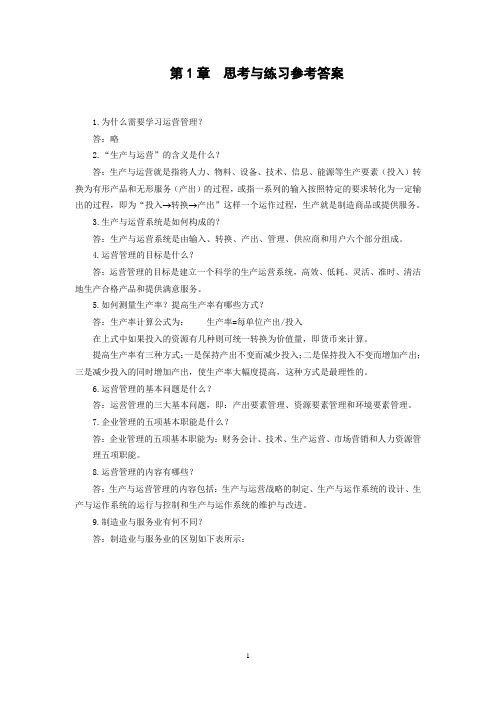
第1章思考与练习参考答案1.为什么需要学习运营管理?答:略2.“生产与运营”的含义是什么?答:生产与运营就是指将人力、物料、设备、技术、信息、能源等生产要素(投入)转换为有形产品和无形服务(产出)的过程,或指一系列的输入按照特定的要求转化为一定输出的过程,即为“投入→转换→产出”这样一个运作过程,生产就是制造商品或提供服务。
3.生产与运营系统是如何构成的?答:生产与运营系统是由输入、转换、产出、管理、供应商和用户六个部分组成。
4.运营管理的目标是什么?答:运营管理的目标是建立一个科学的生产运营系统,高效、低耗、灵活、准时、清洁地生产合格产品和提供满意服务。
5.如何测量生产率?提高生产率有哪些方式?答:生产率计算公式为:生产率=每单位产出/投入在上式中如果投入的资源有几种则可统一转换为价值量,即货币来计算。
提高生产率有三种方式:一是保持产出不变而减少投入;二是保持投入不变而增加产出;三是减少投入的同时增加产出,使生产率大幅度提高,这种方式是最理性的。
6.运营管理的基本问题是什么?答:运营管理的三大基本问题,即:产出要素管理、资源要素管理和环境要素管理。
7.企业管理的五项基本职能是什么?答:企业管理的五项基本职能为:财务会计、技术、生产运营、市场营销和人力资源管理五项职能。
8.运营管理的内容有哪些?答:生产与运营管理的内容包括:生产与运营战略的制定、生产与运作系统的设计、生产与运作系统的运行与控制和生产与运作系统的维护与改进。
9.制造业与服务业有何不同?答:制造业与服务业的区别如下表所示:制造业与服务业的区别10.简述运营管理的发展历程,并指出四位对运营管理的理论和技术有贡献的人。
答:运营管理的发展历程:工业革命时期;科学管理时期;大规模生产时期;精益生产时期;大规模定制时期。
11. 简述现代运营管理的主要特征及其发展趋势。
答:运营管理全求化;生产经营一体化;多品种小批量混合型生产方式成为主流;追求“绿色生产”。
《运营管理》课后习题答案
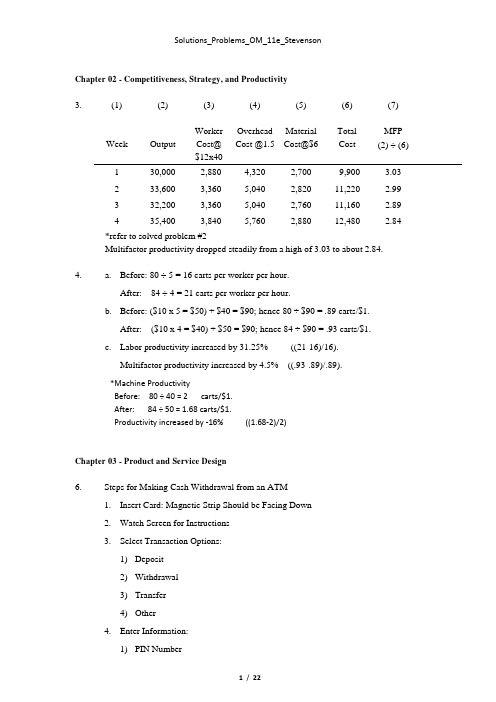
Chapter 02 - Competitiveness, Strategy, and Productivity3. (1) (2) (3) (4) (5) (6) (7)Week Output WorkerCost@$12x40Overhead********MaterialCost@$6TotalCostMFP(2) ÷ (6)1 30,000 2,880 4,320 2,700 9,900 3.032 33,600 3,360 5,040 2,820 11,220 2.993 32,200 3,360 5,040 2,760 11,160 2.894 35,400 3,840 5,760 2,880 12,480 2.84*refer to solved problem #2Multifactor productivity dropped steadily from a high of 3.03 to about 2.84.4. a. Before: 80 ÷ 5 = 16 carts per worker per hour.After: 84 ÷ 4 = 21 carts per worker per hour.b. Before: ($10 x 5 = $50) + $40 = $90; hence 80 ÷ $90 = .89 carts/$1.After: ($10 x 4 = $40) + $50 = $90; hence 84 ÷ $90 = .93 carts/$1.c. Labor productivity increased by 31.25% ((21-16)/16).Multifactor productivity increased by 4.5% ((.93-.89)/.89).*Machine ProductivityBefore: 80 ÷ 40 = 2 carts/$1.After: 84 ÷ 50 = 1.68 carts/$1.Productivity increased by -16% ((1.68-2)/2)Chapter 03 - Product and Service Design6. Steps for Making Cash Withdrawal from an ATM1. Insert Card: Magnetic Strip Should be Facing Down2. Watch Screen for Instructions3. Select Transaction Options:1) Deposit2) Withdrawal3) Transfer4) Other4. Enter Information:1) PIN Number2) Select a Transaction and Account3) Enter Amount of Transaction5. Deposit/Withdrawal: 1) Deposit —place in an envelop e (which you’ll find near or in the ATM) andinsert it into the deposit slot2) Withdrawal —lift the “Withdrawal Door,” being careful to remove all cash6. Remove card and receipt (which serves as the transaction record)8.Chapter 04 - Strategic Capacity Planning for Products and Services2. %80capacityEffective outputActual Efficiency ==Actual output = .8 (Effective capacity) Effective capacity = .5 (Design capacity) Actual output = (.5)(.8)(Effective capacity) Actual output = (.4)(Design capacity) Actual output = 8 jobs Utilization = .4capacityDesign outputActual =n Utilizatiojobs 204.8capacity Effective output Actual Capacity Design ===10. a. Given: 10 hrs. or 600 min. of operating time per day.250 days x 600 min. = 150,000 min. per year operating time.Total processing time by machineProductABC 1 48,000 64,000 32,000 2 48,000 48,000 36,000 3 30,000 36,000 24,000 460,000 60,000 30,000 Total 186,000208,000122,000machine181.000,150000,122machine 238.1000,150000,208machine224.1000,150000,186≈==≈==≈==C B A N N NYou would have to buy two “A” machines at a total cost of $80,000, or two “B” machines at a total cost of $60,000, or one “C” machine at $80,000.b.Total cost for each type of machine:A (2): 186,000 min ÷ 60 = 3,100 hrs. x $10 = $31,000 + $80,000 = $111,000B (2) : 208,000 ÷ 60 = 3,466.67 hrs. x $11 = $38,133 + $60,000 = $98,133 C(1): 122,000 ÷ 60 = 2,033.33 hrs. x $12 = $24,400 + $80,000 = $104,400Buy 2 Bs —these have the lowest total cost.Chapter 05 - Process Selection and Facility Layout3.Desired output = 4Operating time = 56 minutesunit per minutes 14hourper units 4hourper minutes 65output Desired time Operating CT ===Task # of Following tasksPositional WeightA 4 23B 3 20C 2 18D 3 25E 2 18F 4 29G 3 24H 1 14 I5a. First rule: most followers. Second rule: largest positional weight.Assembly Line Balancing Table (CT = 14)b. First rule: Largest positional weight.Assembly Line Balancing Table (CT = 14)c. %36.805645stations of no. x CT time Total Efficiency ===4. a. l.2. Minimum Ct = 1.3 minutesTask Following tasksa 4b 3c 3d 2e 3f 2g 1h3. percent 54.11)3.1(46.CT x N time)(idle percent Idle ==∑=4. 420 min./day 323.1 ( 323)/1.3 min./OT Output rounds to copiers day CT cycle=== b. 1. inutes m 3.224.6N time Total CT ,6.4 time Total ==== 2. Assign a, b, c, d, and e to station 1: 2.3 minutes [no idle time]Assign f, g, and h to station 2: 2.3 minutes3. 420182.6 copiers /2.3OT Output day CT ===4.420 min./dayMaximum Ct is 4.6. Output 91.30 copiers /4.6 min./day cycle==7.Chapter 06 - Work Design and Measurement3. Element PR OT NT AF job ST1 .90.46.414 1.15 .4762 .85 1.505 1.280 1.15 1.4723 1.10.83.913 1.15 1.05041.00 1.16 1.160 1.15 1.334Total4.3328. A = 24 + 10 + 14 = 48 minutes per 4 hours.min 125.720.11x70.5ST .min 70.5)95(.6NT 20.24048A =-=====9. a. Element PR OT NT A ST1 1.10 1.19 1.309 1.15 1.5052 1.15 .83 .955 1.15 1.09831.05.56.588 1.15 .676b.01.A 00.2z 034.s 83.x ==== 222(.034)67.12~68.01(.83)zs n observations ax ⎛⎫⎛⎫===⎪ ⎪⎝⎭⎝⎭c. e = .01 minutes 47 to round ,24.4601.)034(.2e zs n 22=⎪⎭⎫⎝⎛=⎪⎭⎫ ⎝⎛=Chapter 07- Location Planning and Analysis1. Factor Local bank Steel mill Food warehouse Public school1. Convenience forcustomers H L M–H M–H2. Attractiveness ofbuilding H L M M–H3. Nearness to rawmaterials L H L M4. Large amounts ofpower L H L L5. Pollution controls L H L L6. Labor cost andavailability L M L L7. Transportationcosts L M–H M–H M8. Constructioncosts M H M M–HLocation (a) Location (b)4. Factor A B C Weight A B C1. Business Services 9 5 5 2/9 18/9 10/9 10/92. Community Services 7 6 7 1/9 7/9 6/9 7/93. Real Estate Cost 3 8 7 1/9 3/9 8/9 7/94. Construction Costs 5 6 5 2/9 10/9 12/9 10/95. Cost of Living 4 7 8 1/9 4/9 7/9 8/96. Taxes 5 5 5 1/9 5/9 5/9 4/97. Transportation 6 7 8 1/9 6/9 7/9 8/9Total 39 44 45 1.0 53/9 55/9 54/9 Each factor has a weight of 1/7.a. Composite Scores 39 44 45 7 7 7B orC is the best and A is least desirable.b. Business Services and Construction Costs both have a weight of 2/9; the other factors eachhave a weight of 1/9.5 x + 2 x + 2 x = 1 x = 1/9c. Composite ScoresA B C 53/9 55/9 54/9B is the best followed byC and then A.5.Locationx yA 3 7B 8 2C 4 6D 4 1E 6 4Totals 25 20-x =∑x i= 25 = 5.0 -y =∑y i= 20 = 4.0 n 5 n 5Hence, the center of gravity is at (5,4) and therefore the optimal location.Chapter 08 - Management of Quality1. ChecksheetWork Type FrequencyLube and Oil 12Brakes 7Tires 6Battery 4Transmission 1Total 30ParetoLube & Oil Brakes Tires Battery Trans.2 .The run charts seems to show a pattern of errors possibly linked to break times or the end of the shift. Perhaps workers are becoming fatigued. If so, perhaps two 10 minute breaks in the morning and again in the afternoon instead of one 20 minute break could reduce some errors. Also, errors are occurring during the last few minutes before noon and the end of the shift, and those periods should also be given management’s attention.4break lunch break3 2 1 0• • •• • • ••• • • ••••••• ••• •• • •• • •••Chapter 9 - Quality Control4. Sample Mean Range179.48 2.6 Mean Chart: =X ± A 2-R = 79.96 ± 0.58(1.87) 2 80.14 2.3 = 79.96 ± 1.083 80.14 1.2UCL = 81.04, LCL = 78.884 79.60 1.7 Range Chart: UCL = D 4-R = 2.11(1.87) = 3.95 5 80.02 2.0LCL = D 3-R = 0(1.87) = 0680.381.4[Both charts suggest the process is in control: Neither has any points outside the limits.]6. n = 200 Control Limits = np p p )1(2-±Thus, UCL is .0234 and LCL becomes 0.Since n = 200, the fraction represented by each data point is half the amount shown. E.g., 1 defective = .005, 2 defectives = .01, etc.Sample 10 is too large.7. 857.714110c ==Control limits: 409.8857.7c 3c ±=± UCL is 16.266, LCL becomes 0.All values are within the limits.14. Let USL = Upper Specification Limit, LSL = Lower Specification Limit,X = Process mean, σ = Process standard deviationFor process H:}{capablenot ,0.193.93.04.1 ,938.min 04.1)32)(.3(1516393.)32)(.3(1.14153<===-=σ-=-=σ-pk C X USL LSL X 0096.)200(1325==p 0138.0096.200)9904(.0096.20096.±=±=For process K:.1}17.1,0.1min{17.1)1)(3(335.3630.1)1)(3(30333===-=σ-=-=σ- C X USL LSL X pk Assuming the minimum acceptable pk C is 1.33, since 1.0 < 1.33, the process is not capable.For process T:33.1}33.1,67.1min{33.1)4.0)(3(5.181.20367.1)4.0)(3(5.165.183===-=σ-=-=σ- C X USL LSL X pk Since 1.33 = 1.33, the process is capable.Chapter 10 - Aggregate Planning and Master Scheduling7. a.No backlogs are allowedPeriodForecast Output Regular Overtime Subcontract Output - Forecast Inventory Beginning Ending Average Backlog Costs: Regular Overtime Subcontract Inventory Totalb. Level strategyPeriodForecastOutputRegularOvertimeSubcontractOutput - ForecastInventoryBeginningEndingAverageBacklogCosts:RegularOvertimeSubcontractInventoryBacklogTotal8.PeriodForecastOutputRegularOvertimeSubcontractOutput- ForecastInventoryBeginningEndingAverageBacklogCosts:RegularOvertimeSubcontractInventoryBacklogTotalChapter 11 - MRP and ERP1. a. F: 2 G: 1 H: 1J: 2 x 2 = 4 L: 1 x 2 = 2 A: 1 x 4 = 4D: 2 x 4 = 8 J: 1 x 2 = 2 D: 1 x 2 = 2Totals: F = 2; G = 1; H = 1; J = 6; D = 10; L = 2; A = 44. Master Schedule10. Week 1 2 3 4Material 40 80 60 70Week 1 2 3 4Labor hr. 160 320 240 280Mach. hr. 120 240 180 210a. Capacity utilizationWeek 1 2 3 4Labor 53.3% 106.7% 80% 93.3%Machine 60% 120% 90% 105%b. C apacity utilization exceeds 100% for both labor and machine in week 2, and formachine alone in week 4.Production could be shifted to earlier or later weeks in which capacity isunderutilized. Shifting to an earlier week would result in added carrying costs;shifting to later weeks would mean backorder costs.Another option would be to work overtime. Labor cost would increase due toovertime premium, a probable decrease in productivity, and possible increase inaccidents.Chapter 12 - Inventory Management2. The following table contains figures on the monthly volume and unit costs for a random sample of 16 items for a list of 2,000 inventory items.a. See table.b. To allocate control efforts.c. It might be important for some reason other than dollar usage, such as cost of astockout, usage highly correlated to an A item, etc.3. D = 1,215 bags/yr. S = $10 H = $75a. bags HDS Q 187510)215,1(22===b. Q/2 = 18/2 = 9 bagsc.orders ordersbags bags Q D 5.67/ 18 215,1== d . S QD H 2/Q TC +=350,1$675675)10(18215,1)75(218=+=+=e. Assuming that holding cost per bag increases by $9/bag/yearQ ==84)10)(215,1(217 bags71.428,1$71.714714)10(17215,1)84(217=+=+=TCIncrease by [$1,428.71 – $1,350] = $78.714.D = 40/day x 260 days/yr. = 10,400 packagesS = $60 H = $30a. oxes b 20496.2033060)400,10(2H DS 2Q 0====b. S QD H 2Q TC +=82.118,6$82.058,3060,3)60(204400,10)30(2204=+=+=c. Yesd. )60(200400,10)30(2200TC 200+=TC 200 = 3,000 + 3,120 = $6,1206,120 – 6,118.82 (only $1.18 higher than with EOQ, so 200 is acceptable.)7.H = $2/month S = $55D 1 = 100/month (months 1–6)D 2 = 150/month (months 7–12)a. 16.74255)100(2Q :D H DS2Q 010===83.90255)150(2Q :D 02==b. The EOQ model requires this.c. Discount of $10/order is equivalent to S – 10 = $45 (revised ordering cost)1–6 TC74 = $148.32180$)45(150100)2(2150TC 145$)45(100100)2(2100TC *140$)45(50100)2(250TC 15010050=+==+==+=7–12 TC 91 =$181.66195$)45(150150)2(2150TC *5.167$)45(100150)2(2100TC 185$)45(50150)2(250TC 15010050=+==+==+=10. p = 50/ton/day u = 20 tons/day200 days/yr.S = $100 H = $5/ton per yr.a. bags] [10,328 tons 40.5162050505100)000,4(2u p p H DS 2Q 0=-=-=b. ]bags 8.196,6 .approx [ tons 84.309)30(504.516)u p (P Q I max ==-=Average is92.154248.309:2I max =tons [approx. 3,098 bags] c. Run length =days 33.10504.516P Q == d. Runs per year = 8] approx .[ 7.754.516000,4QD == e. Q ' = 258.2TC =S QD H 2I max + TC orig. = $1,549.00 TC rev. = $ 774.50Savings would be $774.50D= 20 tons/day x 200 days/yr. = 4,000 tons/yr.15. RangeP H Q D = 4,900 seats/yr. 0–999 $5.00 $2.00 495 H = .4P 1,000–3,999 4.95 1.98 497 NF S = $50 4,000–5,999 4.90 1.96 500 NF 6,000+ 4.85 1.94503 NFCompare TC 495 with TC for all lower price breaks:TC 495 =495 ($2) + 4,900($50) + $5.00(4,900) = $25,490 2 495 TC 1,000 = 1,000 ($1.98) + 4,900($50) + $4.95(4,900) = $25,4902 1,000 TC 4,000 = 4,000 ($1.96) + 4,900($50) + $4.90(4,900) = $27,9912 4,000 TC 6,000 = 6,000 ($1.94) + 4,900($50) + $4.85(4,900) = $29,6262 6,000Hence, one would be indifferent between 495 or 1,000 units 22. d = 30 gal./day ROP = 170 gal. LT = 4 days,ss = Z σd LT = 50 galRisk = 9% Z = 1.34 Solving, σd LT = 37.31 3% Z = 1.88, ss=1.88 x 37.31 = 70.14 gal.Chapter 13 - JIT and Lean Operations1. N = ?N = DT(1 + X)D = 80 pieces per hourC T = 75 min. = 1.25 hr. = 80(1.25) (1.35)= 3C = 45 45X = .35QuantityTC4. The smallest daily quantity evenly divisible into all four quantities is 3. Therefore, usethree cycles.Product Daily quantity Units per cycleA 21 21/3 = 7B 12 12/3 = 4C 3 3/3 = 1D 15 15/3 = 55.a. Cycle 1 2 3 4A 6 6 5 5B 3 3 3 3C 1 1 1 1D 4 4 5 5E 2 2 2 2 b. Cycle 1 2A 11 11B 6 6C 2 2D 8 8E 4 4c. 4 cycles = lower inventory, more flexibility2 cycles = fewer changeovers7. Net available time = 480 – 75 = 405. Takt time = 405/300 units per day = 1.35 minutes. Chapter 15 - Scheduling6. a. FCFS: A–B–C–DSPT: D–C–B–AEDD: C–B–D–ACR: A–C–D–BFCFS: Job time Flow time Due date DaysJob (days) (days) (days) tardyA 14 14 20 0B 10 24 16 8C 7 31 15 16D 6 37 17 2037 106 44SPT: Job time Flow time Due date Days Job (days) (days) (days) tardyD 6 6 17 0C 7 13 15 0B 10 23 16 7A 14 37 20 1737 79 24EDD:Job D has the lowest critical ratio therefore it is scheduled next and completed on day 27.b.ardi Flow time Average flow time Number of jobsDays tardy Average job t ness Number of jobs Flow timeAverage number of jobs at the center Makespan==∑=FCFS SPT EDD CR26.50 19.75 21.00 24.75 11.0 6.00 6.00 9.25 2.86 2.142.272.67c. SPT is superior.9.Thus, the sequence is b-a-g-e-f-d-c.。
《运营管理》课后习题标准答案
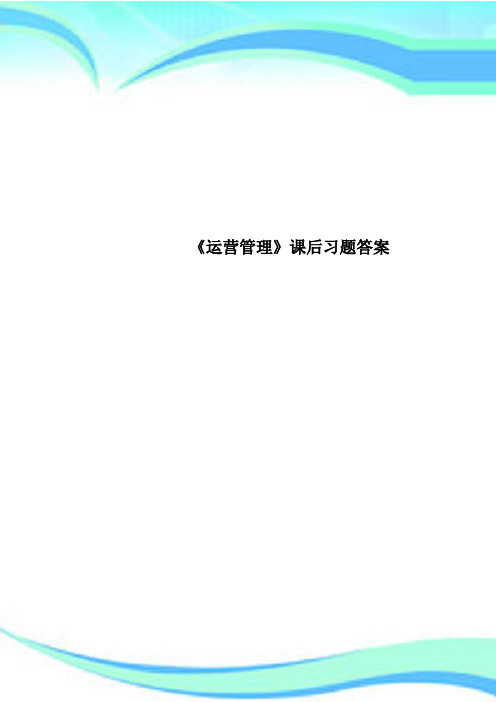
《运营管理》课后习题答案————————————————————————————————作者:————————————————————————————————日期:2Chapter 02 - Competitiveness, Strategy, and Productivity3. (1) (2) (3) (4) (5) (6) (7)Week Output WorkerCost@$12x40Overhead********MaterialCost@$6TotalCostMFP(2) ÷ (6)1 30,000 2,880 4,320 2,700 9,900 3.032 33,600 3,360 5,040 2,820 11,220 2.993 32,200 3,360 5,040 2,760 11,160 2.894 35,400 3,840 5,760 2,880 12,480 2.84*refer to solved problem #2Multifactor productivity dropped steadily from a high of 3.03 to about 2.84.4. a. Before: 80 ÷ 5 = 16 carts per worker per hour.After: 84 ÷ 4 = 21 carts per worker per hour.b. Before: ($10 x 5 = $50) + $40 = $90; hence 80 ÷ $90 = .89 carts/$1.After: ($10 x 4 = $40) + $50 = $90; hence 84 ÷ $90 = .93 carts/$1.c. Labor productivity increased by 31.25% ((21-16)/16).Multifactor productivity increased by 4.5% ((.93-.89)/.89).*Machine ProductivityBefore: 80 ÷ 40 = 2 carts/$1.After: 84 ÷ 50 = 1.68 carts/$1.Productivity increased by -16% ((1.68-2)/2)Chapter 03 - Product and Service Design6. Steps for Making Cash Withdrawal from an ATM1. Insert Card: Magnetic Strip Should be Facing Down2. Watch Screen for Instructions3. Select Transaction Options:1) Deposit2) Withdrawal3) Transfer4) Other4. Enter Information:1) PIN Number2) Select a Transaction and Account3) Enter Amount of Transaction5. Deposit/Withdrawal: 1) Deposit —place in an envelope (which you’ll find near or in the ATM) andinsert it into the deposit slot2) Withdrawal —lift the “Withdrawal Door,” being careful to remove all cash6. Remove card and receipt (which serves as the transaction record)8.TechnicalRequirements IngredientsHandlingPreparationCustomer RequirementsTaste √√ Appearance√ √√Texture/consistency√√Chapter 04 - Strategic Capacity Planning for Products and Services2. %80capacityEffective outputActual Efficiency ==Actual output = .8 (Effective capacity) Effective capacity = .5 (Design capacity) Actual output = (.5)(.8)(Effective capacity) Actual output = (.4)(Design capacity) Actual output = 8 jobs Utilization = .4capacityDesign outputActual =n Utilizatiojobs 204.8capacity Effective output Actual Capacity Design ===10. a. Given: 10 hrs. or 600 min. of operating time per day.250 days x 600 min. = 150,000 min. per year operating time.Total processing time by machineProductABC 1 48,000 64,000 32,000 2 48,000 48,000 36,000 3 30,000 36,000 24,000 460,000 60,000 30,000 Total 186,000208,000122,000machine181.000,150000,122machine 238.1000,150000,208machine224.1000,150000,186≈==≈==≈==C B A N N NYou would have to buy two “A” machines at a total cost of $80,000, or two “B” machines at a total cost of $60,000, or one “C” machine at $80,000.b.Total cost for each type of machine:A (2): 186,000 min ÷ 60 = 3,100 hrs. x $10 = $31,000 + $80,000 = $111,000B (2) : 208,000 ÷ 60 = 3,466.67 hrs. x $11 = $38,133 + $60,000 = $98,133 C(1): 122,000 ÷ 60 = 2,033.33 hrs. x $12 = $24,400 + $80,000 = $104,400Buy 2 Bs —these have the lowest total cost.Chapter 05 - Process Selection and Facility Layout3.3 adf752 b4 c4 e9 h5 i6 gDesired output = 4Operating time = 56 minutesunit per minutes 14hourper units 4hourper minutes 65output Desired time Operating CT ===Task # of Following tasksPositional WeightA 4 23B 3 20C 2 18D 3 25E 2 18F 4 29G 3 24H 1 14 I5a. First rule: most followers. Second rule: largest positional weight.Assembly Line Balancing Table (CT = 14)Work StationTask Task TimeTime RemainingFeasible tasksRemainingIF 5 9 A,D,G A 3 6 B,G G6 – – II D7 7 B, E B 2 5 C C4 1 – III E 4 10 H H9 1 – IV I59–b. First rule: Largest positional weight.Assembly Line Balancing Table (CT = 14)Work StationTask Task TimeTime RemainingFeasible tasks RemainingIF 5 9 A,D,G D7 2 – II G 6 8 A, E A 3 5 B,E B2 3 – III C 4 10 E E4 6 – IV H 95 I I5–c. %36.805645stations of no. x CT time Total Efficiency ===4. a. l.2. Minimum Ct = 1.3 minutesTask Following tasksa 4b 3c 3d 2e 3f 2g 1habd cfeghWork StationEligible Assign Time RemainingIdle TimeIa A 1.1 b,c,e, (tie)B 0.7C 0.4E 0.3 0.3 II d D 0.0 0.0 IIIf,g F 0.5G 0.2 0.2 IVh H 0.1 0.10.63. percent 54.11)3.1(46.CT x N time)(idle percent Idle ==∑=4. 420 min./day 323.1 ( 323)/1.3 min./OT Output rounds to copiers day CT cycle=== b. 1. inutes m 3.224.6N time Total CT ,6.4 time Total ==== 2. Assign a, b, c, d, and e to station 1: 2.3 minutes [no idle time]Assign f, g, and h to station 2: 2.3 minutes3. 420182.6 copiers /2.3OT Output day CT ===4.420 min./dayMaximum Ct is 4.6. Output 91.30 copiers /4.6 min./day cycle==7. 1 5 4 3 8 762Chapter 06 - Work Design and Measurement3. Element PR OT NT AF job ST1 .90.46.414 1.15 .4762 .85 1.505 1.280 1.15 1.4723 1.10.83.913 1.15 1.05041.00 1.16 1.160 1.15 1.334Total4.3328. A = 24 + 10 + 14 = 48 minutes per 4 hours.min 125.720.11x70.5ST .min 70.5)95(.6NT 20.24048A =-=====9. a. Element PR OT NT A ST1 1.10 1.19 1.309 1.15 1.5052 1.15 .83 .955 1.15 1.09831.05.56.588 1.15 .676b.01.A 00.2z 034.s 83.x ==== 222(.034)67.12~68.01(.83)zs n observations ax ⎛⎫⎛⎫===⎪ ⎪⎝⎭⎝⎭c. e = .01 minutes 47 to round ,24.4601.)034(.2e zs n 22=⎪⎭⎫⎝⎛=⎪⎭⎫ ⎝⎛=Chapter 07- Location Planning and Analysis1. Factor Local bank Steel mill Food warehouse Public school1. Convenience forcustomers H L M–H M–H2. Attractiveness ofbuilding H L M M–H3. Nearness to rawmaterials L H L M4. Large amounts ofpower L H L L5. Pollution controls L H L L6. Labor cost andavailability L M L L7. Transportationcosts L M–H M–H M8. Constructioncosts M H M M–HLocation (a) Location (b)4. Factor A B C Weight A B C1. Business Services 9 5 5 2/9 18/9 10/9 10/92. Community Services 7 6 7 1/9 7/9 6/9 7/93. Real Estate Cost 3 8 7 1/9 3/9 8/9 7/94. Construction Costs 5 6 5 2/9 10/9 12/9 10/95. Cost of Living 4 7 8 1/9 4/9 7/9 8/96. Taxes 5 5 5 1/9 5/9 5/9 4/97. Transportation 6 7 8 1/9 6/9 7/9 8/9Total 39 44 45 1.0 53/9 55/9 54/9 Each factor has a weight of 1/7.a. Composite Scores 39 44 45 7 7 7B orC is the best and A is least desirable.b. Business Services and Construction Costs both have a weight of 2/9; the other factors eachhave a weight of 1/9.5 x + 2 x + 2 x = 1 x = 1/9c. Composite ScoresA B C 53/9 55/9 54/9B is the best followed byC and then A.5.Locationx yA 3 7B 8 2C 4 6D 4 1E 6 4Totals 25 20-x =∑x i= 25 = 5.0 -y =∑y i= 20 = 4.0 n 5 n 5Hence, the center of gravity is at (5,4) and therefore the optimal location.Chapter 08 - Management of Quality1. ChecksheetWork Type FrequencyLube and Oil 12Brakes 7Tires 6Battery 4Transmission 1Total 30Pareto127641 Lube & Oil Brakes Tires Battery Trans.2 .The run charts seems to show a pattern of errors possibly linked to break times or the end of the shift. Perhaps workers are becoming fatigued. If so, perhaps two 10 minute breaks in the morning and again in the afternoon instead of one 20 minute break could reduce some errors. Also, errors are occurring during the last few minutes before noon and the end of the shift, and those periods should also be given management’s attention.4Power Per LamMissDidn’Not OutletDefectBurn LoosLampOtheCordbreak lunch3 2•• •• •• • ••• • ••• •••• ••• •• • •• • •••Chapter 9 - Quality Control4. Sample Mean Range179.48 2.6 Mean Chart: =X ± A 2-R = 79.96 ± 0.58(1.87) 2 80.14 2.3 = 79.96 ± 1.083 80.14 1.2UCL = 81.04, LCL = 78.884 79.60 1.7 Range Chart: UCL = D 4-R = 2.11(1.87) = 3.95 5 80.02 2.0LCL = D 3-R = 0(1.87) = 0680.381.4[Both charts suggest the process is in control: Neither has any points outside the limits.]6. n = 200 Control Limits = np p p )1(2-±Thus, UCL is .0234 and LCL becomes 0.Since n = 200, the fraction represented by each data point is half the amount shown. E.g., 1 defective = .005, 2 defectives = .01, etc.Sample 10 is too large.7. 857.714110c ==Control limits: 409.8857.7c 3c ±=± UCL is 16.266, LCL becomes 0.All values are within the limits.14. Let USL = Upper Specification Limit, LSL = Lower Specification Limit,X = Process mean, σ = Process standard deviationFor process H:}{capablenot ,0.193.93.04.1 ,938.min 04.1)32)(.3(1516393.)32)(.3(1.14153<===-=σ-=-=σ-pk C X USL LSL X 0096.)200(1325==p 0138.0096.200)9904(.0096.20096.±=±=For process K:.1}17.1,0.1min{17.1)1)(3(335.3630.1)1)(3(30333===-=σ-=-=σ- C X USL LSL X pk Assuming the minimum acceptable pk C is 1.33, since 1.0 < 1.33, the process is not capable.For process T:33.1}33.1,67.1min{33.1)4.0)(3(5.181.20367.1)4.0)(3(5.165.183===-=σ-=-=σ- C X USL LSL X pk Since 1.33 = 1.33, the process is capable.Chapter 10 - Aggregate Planning and Master Scheduling7. a.No backlogs are allowedPeriod Mar. Apr. May Jun. July Aug. Sep. TotalForecast 50 44 55 60 50 40 51 350 Output Regular 40 40 40 40 40 40 40 280 Overtime 8 8 8 8 8 3 8 51 Subcontract 2 0 3 12 2 0 0 19 Output - Forecast 0 4 –4 0 0 3 –3 Inventory Beginning 0 0 4 0 0 0 3 Ending 0 4 0 0 0 3 0 Average 0 2 2 0 0 1.5 1.5 7 Backlog 0 0 0 0 0 0 0 0 Costs: Regular 3,200 3,200 3,200 3,200 3,200 3,200 3,200 22,400 Overtime 960 960 960 960 960 360 960 6,120 Subcontract 280 0 420 1,680280 0 0 2,660 Inventory 0 20 20 0 0 15 15 70 Total4,4404,1804,6005,8404,4403,575 4,17531,250b. Level strategyPeriod Mar. Apr. May Jun. July Aug. Sep. Total Forecast 50 44 55 60 50 40 51 350 OutputRegular 40 40 40 40 40 40 40 280 Overtime 8 8 8 8 8 8 8 56 Subcontract 2 2 2 2 2 2 2 14 Output - Forecast 0 6 –5 –10 0 10 –1InventoryBeginning 0 0 6 1 0 0 1Ending 0 6 1 0 0 1 0Average 0 3 3.5 .5 0 .5 .5 8 Backlog 0 0 0 9 9 0 0 18 Costs:Regular 3,200 3,200 3,200 3,200 3,200 3,200 3,200 22,400 Overtime 960 960 960 960 960 960 960 6,720 Subcontract 280 280 280 280 280 280 280 1,960 Inventory 30 35 5 0 5 5 80 Backlog 180 180 360 Total 4,440 4,470 4,475 4,625 4,620 4,445 4,445 31,520 8.Period 1 2 3 4 5 6 TotalForecast 160 150 160 180 170 140 960OutputRegular 150 150 150 150 160 160 920Overtime 10 10 0 10 10 10 50Subcontract 0 0 10 10 0 0 20Output- Forecast 0 10 0 –10 0 0InventoryBeginning 0 0 10 10 0 0Ending 0 10 10 0 0 0Average 0 5 10 5 0 0 20Backlog 0 0 0 0 0 0 0Costs:Regular 7,500 7,500 7,500 7,500 8,000 8,000 46,000Overtime 750 750 0 750 750 750 3,750Subcontract 0 0 800 800 0 0 1,600Inventory 20 40 20 80Backlog 0 0 0 0 0 0Total 8,250 8,270 8,340 9,070 9,050 8,750 51,430Chapter 11 - MRP and ERP1. a. F: 2 G: 1 H: 1J: 2 x 2 = 4 L: 1 x 2 = 2 A: 1 x 4 = 4D: 2 x 4 = 8 J: 1 x 2 = 2 D: 1 x 2 = 2Totals: F = 2; G = 1; H = 1; J = 6; D = 10; L = 2; A = 4b.4. Master Schedule Day Beg. Inv. 1 2 3 4 5 6 7 Quantity100 150 200 TableBeg. Inv. 1 2 3 4 5 6 7 Gross requirements 100 150 200 Scheduled receipts Projected on hand Net requirements 100 150 200 Planned-order receipts 100 150 200 Planned-order releases 100 150 200Wood Sections Beg. Inv. 1 2 3 4 5 6 7 Gross requirements 200300 400 Scheduled receipts 100 Projected on hand 100100 Net requirements 100 300 400 Planned-order receipts 100 300 400 Planned-order releases400 400Braces Beg. Inv. 1 2 3 4 5 6 7 Gross requirements 300 450 600 Scheduled receipts Projected on hand 60 60 60 60 Net requirements 240 450 600 Planned-order receipts 240 450 600Planned-order releases 240 450 600StaplerTopBaseCoveSpri SlideBase Strik RubberSlidSpriLegs Beg.Inv.1 2 3 4 5 6 7Gross requirements 400 600 800Scheduled receiptsProjected on hand 120 120 120 120 88 88 71 Net requirements 280 600 800Planned-order receipts 308 660 880Planned-order releases 968 88010. Week 1 2 3 4Material 40 80 60 70Week 1 2 3 4Labor hr. 160 320 240 280Mach. hr. 120 240 180 210a. Capacity utilizationWeek 1 2 3 4Labor 53.3% 106.7% 80% 93.3%Machine 60% 120% 90% 105%b. C apacity utilization exceeds 100% for both labor and machine in week 2, and formachine alone in week 4.Production could be shifted to earlier or later weeks in which capacity isunderutilized. Shifting to an earlier week would result in added carrying costs;shifting to later weeks would mean backorder costs.Another option would be to work overtime. Labor cost would increase due toovertime premium, a probable decrease in productivity, and possible increase inaccidents.Chapter 12 - Inventory Management2. The following table contains figures on the monthly volume and unit costs for a random sample of 16 items for a list of 2,000 inventory items. DollarItemUnit Cost UsageUsageCategoryK34 10 200 2,000 C K35 25 600 15,000 A K36 36 150 5,400 B M10 16 25 400 C M20 20 80 1,600 C Z45 80 250 16,000 A F14 20 300 6,000 B F95 30 800 24,000 A F99 20 60 1,200 C D45 10 550 5,500 B D48 12 90 1,080 C D52 15 110 1,650 C D57 40 120 4,800 B N08 30 40 1,200 C P05 16 500 8,000 BP091030300Ca. See table.b. To allocate control efforts.c. It might be important for some reason other than dollar usage, such as cost of astockout, usage highly correlated to an A item, etc.3. D = 1,215 bags/yr. S = $10 H = $75a. bags HDS Q 187510)215,1(22===b. Q/2 = 18/2 = 9 bagsc.orders ordersbags bags Q D 5.67/ 18 215,1== d . S QD H 2/Q TC +=350,1$675675)10(18215,1)75(218=+=+=e. Assuming that holding cost per bag increases by $9/bag/yearQ ==84)10)(215,1(217 bags71.428,1$71.714714)10(17215,1)84(217=+=+=TCIncrease by [$1,428.71 – $1,350] = $78.714.D = 40/day x 260 days/yr. = 10,400 packagesS = $60 H = $30a. oxes b 20496.2033060)400,10(2H DS 2Q 0====b. S QD H 2Q TC +=82.118,6$82.058,3060,3)60(204400,10)30(2204=+=+=c. Yesd. )60(200400,10)30(2200TC 200+=TC 200 = 3,000 + 3,120 = $6,1206,120 – 6,118.82 (only $1.18 higher than with EOQ, so 200 is acceptable.)7.H = $2/month S = $55D 1 = 100/month (months 1–6)D 2 = 150/month (months 7–12)a. 16.74255)100(2Q :D H DS2Q 010===83.90255)150(2Q :D 02==b. The EOQ model requires this.c. Discount of $10/order is equivalent to S – 10 = $45 (revised ordering cost)1–6 TC74 = $148.32180$)45(150100)2(2150TC 145$)45(100100)2(2100TC *140$)45(50100)2(250TC 15010050=+==+==+=7–12 TC 91 =$181.66195$)45(150150)2(2150TC *5.167$)45(100150)2(2100TC 185$)45(50150)2(250TC 15010050=+==+==+=10. p = 50/ton/day u = 20 tons/day200 days/yr. S = $100 H = $5/ton per yr.a. bags] [10,328 tons 40.5162050505100)000,4(2u p p H DS 2Q 0=-=-=b. ]bags 8.196,6 .approx [ tons 84.309)30(504.516)u p (P Q I max ==-=Average is92.154248.309:2I max =tons [approx. 3,098 bags] c. Run length =days 33.10504.516P Q == d. Runs per year = 8] approx .[ 7.754.516000,4QD == e. Q ' = 258.2TC =S QD H 2I max + TC orig. = $1,549.00 TC rev. = $ 774.50Savings would be $774.50D= 20 tons/day x 20015. RangeP H Q D = 4,900 seats/yr. 0–999 $5.00 $2.00 495 H = .4P 1,000–3,999 4.95 1.98 497 NF S = $50 4,000–5,999 4.90 1.96 500 NF 6,000+4.851.94503 NFCompare TC 495 with TC for all lower price breaks:TC 495 =495 ($2) + 4,900($50) + $5.00(4,900) = $25,490 2 495 TC 1,000 = 1,000 ($1.98) + 4,900($50) + $4.95(4,900) = $25,4902 1,000 TC 4,000 = 4,000 ($1.96) + 4,900($50) + $4.90(4,900) = $27,9912 4,000 TC 6,000 = 6,000 ($1.94) + 4,900($50) + $4.85(4,900) = $29,6262 6,000Hence, one would be indifferent between 495 or 1,000 units 22. d = 30 gal./day ROP = 170 gal. LT = 4 days,ss = Z σd LT = 50 galRisk = 9% Z = 1.34 Solving, σd LT = 37.31 3% Z = 1.88, ss=1.88 x 37.31 = 70.14 gal.Chapter 13 - JIT and Lean Operations1. N = ?N = DT(1 + X)D = 80 pieces per hourC T = 75 min. = 1.25 hr. = 80(1.25) (1.35)= 3C = 45 45X = .35• •• •495 497 500 5031,0004,000 6,000QuantityTC4. The smallest daily quantity evenly divisible into all four quantities is 3. Therefore, usethree cycles.Product Daily quantity Units per cycleA 21 21/3 = 7B 12 12/3 = 4C 3 3/3 = 1D 15 15/3 = 55.a. Cycle 1 2 3 4A 6 6 5 5B 3 3 3 3C 1 1 1 1D 4 4 5 5E 2 2 2 2 b. Cycle 1 2A 11 11B 6 6C 2 2D 8 8E 4 4c. 4 cycles = lower inventory, more flexibility2 cycles = fewer changeovers7. Net available time = 480 – 75 = 405. Takt time = 405/300 units per day = 1.35 minutes. Chapter 15 - Scheduling6. a. FCFS: A–B–C–DSPT: D–C–B–AEDD: C–B–D–ACR: A–C–D–BFCFS: Job time Flow time Due date DaysJob (days) (days) (days) tardyA 14 14 20 0B 10 24 16 8C 7 31 15 16D 6 37 17 2037 106 44SPT: Job time Flow time Due date Days Job (days) (days) (days) tardyD 6 6 17 0C 7 13 15 0B 10 23 16 7A 14 37 20 1737 79 24EDD: Job time Flow time Due date DaysJob (days) (days) (days) tardyC 7 7 15 0B 10 17 16 1D 6 23 17 6A 14 37 20 1784 24Critical RatioJob Processing Time(Days) Due Date Critical Ratio CalculationA 14 20 (20 – 0) / 14 = 1.43B 10 16 (16 – 0) /10 = 1.60C 7 15 (15 – 0) / 7 = 2.14D 6 17 (17 – 0) / 6 = 2.83Job A has the lowest critical ratio, therefore it is scheduled first and completed on day 14. After the completion of Job A, the revised critical ratios are:Job Processing Time(Days) Due Date Critical Ratio CalculationA –––B 10 16 (16 – 14) /10 = 0.20C 7 15 (15 – 14) / 7 = 0.14D 6 17 (17 – 14) / 6 = 0.50Job C has the lowest critical ratio, therefore it is scheduled next and completed on day 21. After the completion of Job C, the revised critical ratios are:Job Processing Time(Days) Due Date Critical Ratio CalculationA –––B 10 16 (16 – 21) /10 = –0.50C –––D 6 17 (17 – 21) / 6 = –0.67Job D has the lowest critical ratio therefore it is scheduled next and completed on day 27. The critical ratio sequence is A –C –D –B and the makespan is 37 days. Critical Ratio sequenceProcessing Time(Days)Flow time Due Date TardinessA 14 14 20 0 C 7 21 15 6 D 6 27 17 10 B1037 16 21 ∑9937b.ardi Flow time Average flow time Number of jobsDays tardy Average job t ness Number of jobs Flow timeAverage number of jobs at the center Makespan==∑=FCFS SPT EDD CR26.50 19.75 21.00 24.75 11.0 6.00 6.00 9.25 2.86 2.142.272.67c. SPT is superior.9.Time (hr.) Sequence of assignment:Order Step 1 Step 2A 1.20 1.40 .80 [C] last (or 7th)B 0.90 1.30 .90 [B] firstC 2.00 0.80 1.20 [A] 2ndD 1.70 1.50 1.30 [G] 3rdE 1.60 1.80 1.60 [E] 4thF 2.20 1.75 1.50 [D] 6th G1.301.401.75[F]5thThus, the sequence is b-a-g-e-f-d-c.。
《运营管理》威廉.史蒂文森著,张群、张杰、马风才译,机械工业出版社(第11版课后习题答案)

23 0.96 0.01749
材料/磅 多要素生产率
1
30000 6
450
9900 3.03
2
33600 7
470
11220 2.99
3
32200 7
460
11160 2.89
4
35400 8
480
12480 2.84
第4题 工人
买设备前 买设备后
美元/小时 生产率
每小时产量 劳动成本 机器成本 劳动 多要素
5
80
10
40
16
0.89
第1题
庆典 婚宴
工人
套餐 8 6
生产率
300
37.5 低
240
40 高
为什
第2题 周
小组人数 铺放码数 生产率
1
4
96
24
2
3
72
24
3
4
92
23
4
2
50
25
5
3
69
23
6
2
52
26
人数与生产率?
第3题 周工作
40H
工资 12﹩/H
材料成本 6﹩/磅
单价 140
管理费 周劳动成 本1.5倍
周
产量 工人
2
3.5
400 6.30
28
2
3.6
400 6.71
第9题 雇员
周工作/ 人
工时费/H
合约数
材料费 管理费
3
40
25
360 1000 9000
3
生产率 1.938462
2小题 生产率
日接待顾 客
运营管理第6版习题与参考答案_第05章

习题与参考答案第05章一、名词解释1、选址规划答案:定工厂或服务设施的位置,涉及两个层面:第一个是选位,即选择一定的区域,如国家、地区、省市等;第二个层面是定址,即选择工厂或服务设施的具体地址。
答案解析:略。
难易程度:易。
知识点:选址规划。
2、因素评分法答案:对影响决策问题的主要因素进行评分,并根据其影响决策问题的重要性,对备选方案进行综合评分,在此基础上选择最佳决策方案。
答案解析:略。
难易程度:中。
知识点:因素评分法。
3、重心法答案:根据重心在物理上的这种含义,借助重心来辅助选择经济中心(如物流配送中心、仓储中心、销售中心、社区医院等)的地理位置,使从该经济中心到各个配送目的地的总的配送成本最低。
答案解析:略。
难易程度:中。
知识点:重心法。
二、单选题1、在用重心法进行社区医院选址时,计算重心位置时所用的权重应该是()。
A. 距离B. 人口C. 物资量D. 成本答案:B。
答案解析:略。
难易程度:中。
知识点:重心法。
三、多选题无。
四、判断题1、运输模型中物资配送方案的“唯一性”是指理论上只有一个配送方案是最优的。
答案:错。
答案解析:这里的“唯一性”是指最低费用是唯一的。
难易程度:难。
知识点:物资配送方案的“唯一性”。
2、为了科学选址,会引入定量方法。
要选择的位置一定是定量方法所计算出来的最优解。
答案:错。
答案解析:实际中不可能把所有的因素都纳入到定量模型中,用定量方法所计算出来的最优解往往是不可行的。
难易程度:难。
知识点:因素评分法、重心法、运输模型。
五、填空题1、需要选址的情况有三种,即:()、()、()。
答案:新建、增加、搬迁。
答案解析:略。
难易程度:中。
知识点:选址规划的可能性。
六、简答题1、简述需要进行选址的情况。
答案:(1)完全新建。
(2)保留现址并增加新址。
(3)放弃现址而迁至新址。
答案解析:略。
难易程度:易。
知识点:企业选址的可能性。
2、简述选址规划的重要性。
答案:(1)影响企业的竞争力。
运营管理第6版习题与参考答案_第01章
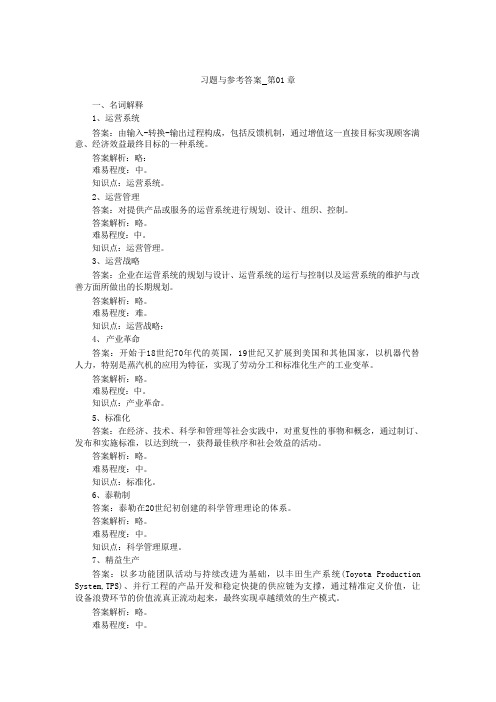
习题与参考答案第01 章一、名词解释1、运营系统答案:由输入-转换-输出过程构成,包括反馈机制,通过增值这一直接目标实现顾客满意、经济效益最终目标的一种系统。
答案解析:略:难易程度:中。
知识点:运营系统。
2、运营管理答案:对提供产品或服务的运营系统进行规划、设计、组织、控制。
答案解析:略。
难易程度:中。
知识点:运营管理。
3、运营战略答案:企业在运营系统的规划与设计、运营系统的运行与控制以及运营系统的维护与改善方面所做出的长期规划。
答案解析:略。
难易程度:难。
知识点:运营战略:4、产业革命答案:开始于18世纪70年代的英国,19世纪又扩展到美国和其他国家,以机器代替人力,特别是蒸汽机的应用为特征,实现了劳动分工和标准化生产的工业变革。
答案解析:略。
难易程度:中。
知识点:产业革命。
5、标准化答案:在经济、技术、科学和管理等社会实践中,对重复性的事物和概念,通过制订、发布和实施标准,以达到统一,获得最佳秩序和社会效益的活动。
答案解析:略。
难易程度:中。
知识点:标准化。
6、泰勒制答案:泰勒在20世纪初创建的科学管理理论的体系。
答案解析:略。
难易程度:中。
知识点:科学管理原理。
7、精益生产答案:以多功能团队活动与持续改进为基础,以丰田生产系统(Toyota Production System,TPS)、并行工程的产品开发和稳定快捷的供应链为支撑,通过精准定义价值,让设备浪费环节的价值流真正流动起来,最终实现卓越绩效的生产模式。
答案解析:略。
难易程度:中。
知识点:精益生产。
8、大规模定制答案:以满足顾客个性化需求为目标,以顾客愿意支付的价格,并以能够获得一定利润的成本高效率地进行定制,从而提高企业适应市场需求变化的灵活性和快速响应能力的先进生产方式。
答案解析:略。
难易程度:难。
知识点:大规模定制。
9、低碳运营模式答案:对企业的碳源进行分析,跟踪碳足迹,测算其碳排放量,以企业内部小循环为支撑,实现投资、技术引进、产品开发等的低碳运营方式。
(完整版)《运营管理》课程习题和答案解析_修订版
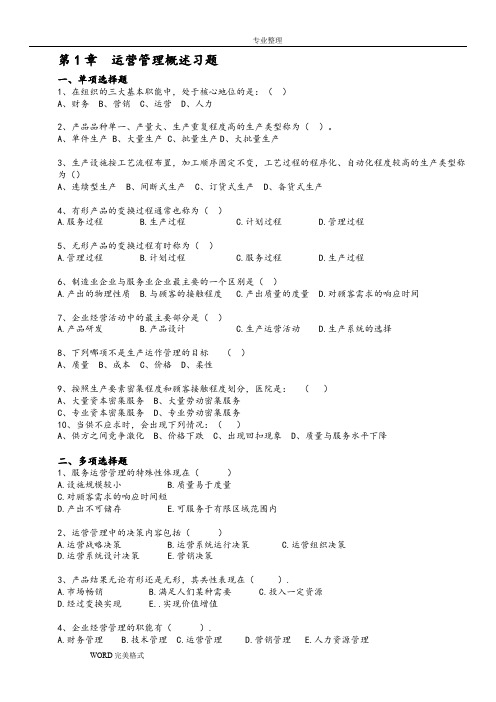
第1章运营管理概述习题一、单项选择题1、在组织的三大基本职能中,处于核心地位的是:()A、财务B、营销C、运营D、人力2、产品品种单一、产量大、生产重复程度高的生产类型称为()。
A、单件生产B、大量生产C、批量生产D、大批量生产3、生产设施按工艺流程布置,加工顺序固定不变,工艺过程的程序化、自动化程度较高的生产类型称为()A、连续型生产B、间断式生产C、订货式生产D、备货式生产4、有形产品的变换过程通常也称为()A.服务过程B.生产过程C.计划过程D.管理过程5、无形产品的变换过程有时称为()A.管理过程B.计划过程C.服务过程D.生产过程6、制造业企业与服务业企业最主要的一个区别是()A.产出的物理性质B.与顾客的接触程度C.产出质量的度量D.对顾客需求的响应时间7、企业经营活动中的最主要部分是()A.产品研发B.产品设计C.生产运营活动D.生产系统的选择8、下列哪项不是生产运作管理的目标()A、质量B、成本C、价格D、柔性9、按照生产要素密集程度和顾客接触程度划分,医院是:()A、大量资本密集服务B、大量劳动密集服务C、专业资本密集服务D、专业劳动密集服务10、当供不应求时,会出现下列情况:()A、供方之间竞争激化B、价格下跌C、出现回扣现象D、质量与服务水平下降二、多项选择题1、服务运营管理的特殊性体现在()A.设施规模较小B.质量易于度量C.对顾客需求的响应时间短D.产出不可储存E.可服务于有限区域范围内2、运营管理中的决策内容包括()A.运营战略决策B.运营系统运行决策C.运营组织决策D.运营系统设计决策E.营销决策3、产品结果无论有形还是无形,其共性表现在().A.市场畅销B.满足人们某种需要C.投入一定资源D.经过变换实现E..实现价值增值4、企业经营管理的职能有().A.财务管理B.技术管理C.运营管理D.营销管理E.人力资源管理5、运营管理的计划职能具体包括以下方面内容()A.目标B.原因C.人员D.地点E.时间F. 方式三、简答题1、根据生产活动的定义,生产活动有哪些含义?2、从管理的角度来看制造过程和服务过程,二者存在哪些重要异同?3、按照产品品种多少和生产的重复程度划分的生产类型有哪些?特点是什么?4、生产运营系统有哪些的主要特征?试对其进行简单描述。
运营管理第2版张华西习题答案
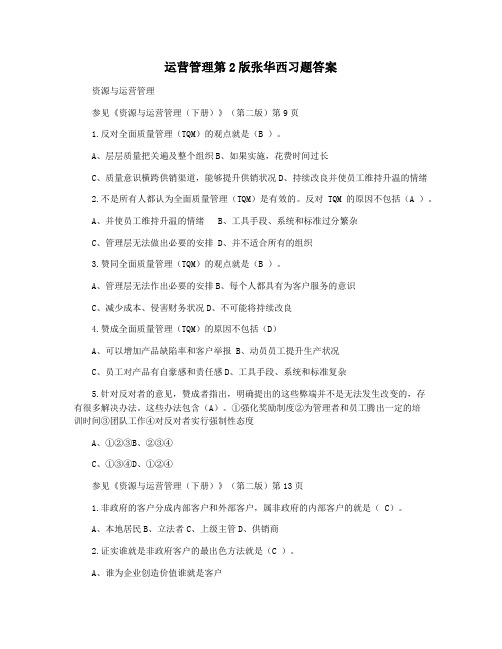
运营管理第2版张华西习题答案资源与运营管理参见《资源与运营管理(下册)》(第二版)第9页1.反对全面质量管理(TQM)的观点就是(B )。
A、层层质量把关遍及整个组织B、如果实施,花费时间过长C、质量意识横跨供销渠道,能够提升供销状况D、持续改良并使员工维持升温的情绪2.不是所有人都认为全面质量管理(TQM)是有效的。
反对TQM的原因不包括(A )。
A、并使员工维持升温的情绪B、工具手段、系统和标准过分繁杂C、管理层无法做出必要的安排D、并不适合所有的组织3.赞同全面质量管理(TQM)的观点就是(B )。
A、管理层无法作出必要的安排B、每个人都具有为客户服务的意识C、减少成本、侵害财务状况D、不可能将持续改良4.赞成全面质量管理(TQM)的原因不包括(D)A、可以增加产品缺陷率和客户举报B、动员员工提升生产状况C、员工对产品有自豪感和责任感D、工具手段、系统和标准复杂5.针对反对者的意见,赞成者指出,明确提出的这些弊端并不是无法发生改变的,存有很多解决办法。
这些办法包含(A)。
①强化奖励制度②为管理者和员工腾出一定的培训时间③团队工作④对反对者实行强制性态度A、①②③B、②③④C、①③④D、①②④参见《资源与运营管理(下册)》(第二版)第13页1.非政府的客户分成内部客户和外部客户,属非政府的内部客户的就是( C)。
A、本地居民B、立法者C、上级主管D、供销商2.证实谁就是非政府客户的最出色方法就是(C )。
A、谁为企业创造价值谁就是客户B、证实非政府内都存有什么人C、分析组织的业务范围和员工所做的工作内容D、证实提供更多产品的对象就是谁3.组织的客户分为内部客户和外部客户,属于组织的外部客户的是(A )。
A、供销商B、其他部门经理C、上级主管D、同事4.柯明是一家公司的总经理,他想确认一下自己的内部客户和外部客户,属于他的外部客户的是(D )。
A、直属B、其他部门经理C、上级领导D、供销商5.关于“谁是组织客户”这一问题的认识,正确的是(B)A、非政府的客户就是非政府提供更多最终产品的对象B、确认好谁是组织的客户后,就需要对他们的需求进行评估C、有的企业不存有内部客户D、竞争对手可以归类为组织的外部客户参看《资源与运营管理(下卷)》(第二版)第15页1.确认客户需求最好的方法是问他们本人,通常不会采用的方式是(C )。
运营管理第6版习题与参考答案_

习题与参考答案_第12章一、名词解释1、作业计划答案:把企业的作业任务分解为短期的具体任务,规定每个环节(如车间、工段、生产线和工作站)、每个单位时间(周、日、班或小时)的具体任务,并组织计划的实施。
答案解析:略。
难易程度:易。
知识点:作业计划。
2、排序答案:确定各个作业在加工中心的处理顺序。
答案解析:略。
难易程度:易。
知识点:排序。
3、先到先服务准则(FCFS)答案:优先选择最早进入可排序列的作业,也就是按照作业到达的先后顺序进行加工。
答案解析:略。
难易程度:中。
知识点:先到先服务准则(FCFS)。
4、最短作业时间准则(SPT)答案:优先选择作业时间最短的作业。
答案解析:略。
难易程度:中。
知识点:最短作业时间准则(SPT)。
5、最早交货期准则(EDD)答案:优先选择完工期限最紧的作业。
答案解析:略。
难易程度:中。
知识点:最早交货期准则(EDD)。
6、最短松驰时间准则(SST)答案:优先选择松弛时间最短的作业。
答案解析:略。
难易程度:中。
知识点:最短松驰时间准则(SST)。
7、最长剩余作业时间准则(MWKR)答案:优先选择余下作业时间最长的作业。
答案解析:略。
难易程度:中。
知识点:最长剩余作业时间准则(MWKR)。
8、最短剩余作业时间准则(LWKR)答案:优先选择余下作业时间最短的作业。
答案解析:略。
难易程度:中。
知识点:最短剩余作业时间准则(LWKR)。
9、最多剩余作业数准则(MOPNR)答案:优先选择余下作业数最多的工件。
答案解析:略。
难易程度:中。
知识点:最多剩余作业数准则(MOPNR)。
10、最小临界比准则(SCR)答案:优先选择临界比最小的作业。
答案解析:略。
难易程度:中。
知识点:最小临界比准则(SCR)。
11、随机准则(Random)答案:随机地挑选出一项作业。
答案解析:略。
难易程度:中。
知识点:随机准则(Random)。
12、生产调度答案:生产调度部门,行使调度权力,协助各级行政领导指挥生产,协调各部门工作,处理生产中出现的问题。
十四版运营管理课后答案

十四版运营管理课后答案运营管理是管理学中的重要领域之一,它关注企业如何高效地组织、协调和控制其产品和服务的生产与交付过程。
在这里,我们整理了十四版运营管理课后习题的答案,以帮助您更好地理解和应用运营管理的概念和方法。
第一章:运营管理导论1.从运营管理的角度看,以下哪些是产品?–一台笔记本电脑–一位医生的服务–一份期刊论文答案:一台笔记本电脑是产品,一位医生的服务是服务,一份期刊论文则是知识或信息的产品。
2.运营管理的基本目标是什么?答案:运营管理的基本目标是通过有效的组织、协调和控制,实现企业产品和服务的高质量、高效率生产与交付,以满足客户需求。
3.运营管理与供应链管理的关系是什么?答案:运营管理与供应链管理密切相关。
供应链管理是指企业通过协调与管理供应链中各个环节的活动,以满足最终客户需求的过程。
运营管理包含在供应链管理中的生产与物流环节,而供应链管理则涵盖了更广泛的供应商、制造商、分销商和客户之间的协调与合作。
4.举例说明企业的运营战略与市场定位之间的关系。
答案:企业的运营战略与市场定位密不可分。
运营战略是指企业在生产与运作过程中选择的基本方法,它必须与企业所选择的市场定位和竞争战略相匹配。
例如,如果企业的市场定位是高端市场,那么运营战略可能包括高品质、高定制化程度的产品和服务;而如果企业的市场定位是低成本领导者,那么运营战略可能注重生产效率和成本控制。
第二章:运营策略与竞争优势1.简述运营策略的定义和基本要素。
答案:运营策略是指企业在生产与运作过程中选择的基本方法和手段,以支持其战略目标的实现。
它包括产品、品质、成本、交付和灵活性等多个方面。
基本要素包括:产品策略(包括产品设计、技术选择等)、品质策略(包括质量控制、质量管理等)、成本策略(包括生产成本控制、成本优化等)、交付策略(包括物流管理、供应链管理等)和灵活性策略(包括生产规模、供应链可变性等)。
2.举例说明运营策略的多样性。
答案:运营策略因企业的战略目标和市场环境的不同而多样化。
运营管理第6版习题与参考答案_第04章

习题与参考答案第04章一、名词解释1、运营能力答案:组织接收、持有、容纳或给付的能力。
答案解析:略。
难易程度:中。
知识点:运营能力。
2、设计能力答案:建厂或扩建后运营系统理论上达到的最大能力。
答案解析:略。
难易程度:中。
知识点:设计能力。
3、有效能力答案:在理想运营条件下能够达到的能力,即交工验收后查定的能力。
答案解析:略。
难易程度:中。
知识点:有效能力。
4、实际能力答案:组织在一定时期内,在既定的有效能力基础上,考虑实际运营条件后能够实现的产出。
答案解析:略。
难易程度;中。
知识点:实际能力。
5、利用率答案:实际能力占设计能力的比率。
答案解析;略。
难易程度:中。
知识点:利用率。
6、效率答案:实际能力占有效能力的比率。
答案解析;略。
难易程度:中。
知识点:效率。
7、规模经济效应答案:所有生产要素按同方向增加(或减少)对产量变动的影响。
答案解析:略。
难易程度:中。
知识点:规模经济效应。
8、能力柔性答案;企业所具备的快速增加或降低某种运营能力的本领,也指快速地从一种运营能力转换为另一种运营能力的本领。
答案解析:略。
难易程度:中。
知识点:能力柔性。
9、盈亏平衡分析答案:根据产品的业务量、成本、利润之间的相互关系,通过确定盈亏平衡点,来判断经营状况的一种数学分析方法。
答案解析:略。
难易程度:中。
知识点:盈亏平衡分析。
10、服务系统利用率答案:服务能力利用的百分比,即平均到达率与平均服务率之比。
答案解析:略。
难易程度:中。
知识点:服务系统利用率。
11、排队长答案:系统中排队等候服务的顾客数。
答案解析:略。
难易程度:中。
知识点:排队长。
12、队长答案:队长是指服务系统中的顾客数,包括正在接受服务的顾客数和排队等候服务的顾客数。
答案解析:略。
难易程度:中。
知识点:队长。
13、等待时间答案:从顾客到达服务系统起到其开始接受服务止的时间间隔。
答案解析:略。
难易程度:中。
知识点:等待时间。
14、逗留时间答案:逗留时间是从顾客到达服务系统起到其接受服务完成止的时间间隔。
运营管理课程同步习题答案

《运营管理》课程同步习题答案第一讲学科导入一、判断题1、服务业的兴起使得传统的生产概念得以扩展。
A、正确B、错误2、制造业的本质是从自然界直接提取所需的物品。
A、正确B、错误3、服务业不仅制造产品,往往还要消耗产品,因此服务业不创造价值。
A、正确B、错误4、教育不属于服务业。
A、正确B、错误5、服务业的兴起是社会生产力发展的必然结果。
A、正确B、错误6、服务业的兴起是社会生产力发展水平的一个标志。
A、正确B、错误7、有什么样的原材料就制造什么样的产品,是输入决定了输出。
A、正确B、错误8、生产运作是一切社会组织都要从事的活动。
A、正确B、错误9、不论其规模大小,只要是汽车制造厂,其生产系统就是一样的。
A、正确B、错误10、运作、营销和财务三大职能在大多数组织中都互不相干地运作。
A、正确B、错误11、运作职能只在生产物品的公司中存在。
A、正确B、错误12、运作管理包括系统设计、系统运作和系统改进三大部分。
A、正确B、错误13、运作管理只是对制造业而言。
A、正确B、错误14、选址不是运作管理的内容。
A、正确B、错误15、生产运作管理包括对生产运作活动进行计划、组织和控制。
A、正确B、错误16、运作经理不对运作系统设计负责。
A、正确B、错误17、生产管理者只要懂得如何组织生产过程就行。
A、正确B、错误18、增值(value-added)是输出的价值或价格和输入的费用之间的差别。
A、正确B、错误19、流程式生产有较多标准化的产品。
A、正确B、错误20、加工装配式生产是离散性生产。
A、正确B、错误21、加工装配式生产的能力可以明确规定。
A、正确B、错误22、按照物流的特征,炼油厂属于V型企业。
A、正确B、错误23.按照物流的特征,汽车制造厂属于V型企业。
A、正确B、错误24、备货型生产(make to stock)的产品个性化程度高。
A、正确B、错误25、订货型生产(make to order)的产效率较低。
《运营管理》教材作业参考答案
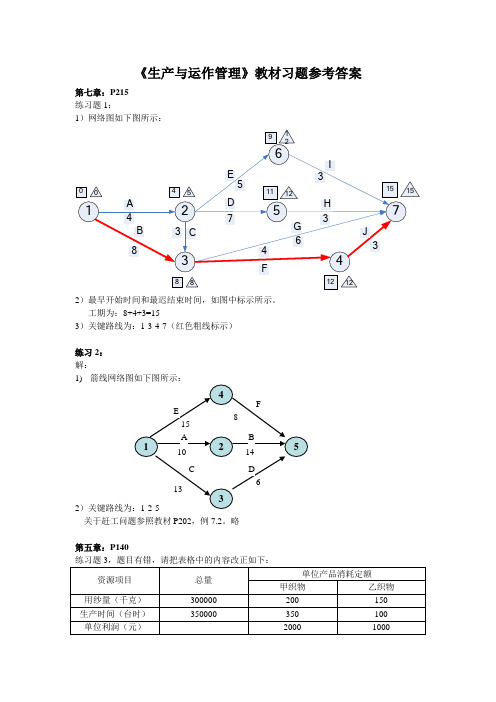
《生产与运作管理》教材习题参考答案第七章:P215 练习题1:1)网络图如下图所示:2)最早开始时间和最迟结束时间,如图中标示所示。
工期为:8+4+3=153)关键路线为:1-3-4-7(红色粗线标示)练习2: 解:1)2 关于赶工问题参照教材P202,例7.2。
略第五章:P140答案参见教材:P118,例5.6,略第四章:P95 练习题1:12)车间布置:根据关系分数排序,题目条件或约束,确定好车间7、2、4、1(注意车间1不能位于厂区中间位置,故列于最左下);车间3与车间2的关系为A ,故安排于其左或右;车间8与车间4关系为A ,可安排于其上或其右;车间3、5、8的安排根据其相邻的所有车间的关系密切程度之和可以计算(略),可知车间5位于车间4上,车间8位于车间4右,车间3位于车间1上。
车间6与车间8的关系为A ,故车间6位于车间8上。
最终结果如图示:第三章:P61练习题1:解:Y=0.5X40+0.35X30+0.20X10=32.5 城市2综合得分高,因此是最佳选择。
练习题3. 解:设采用营口冷库,则如下表所示:其运输总费用=210*10+60*12+70*17+10*20+150*11+160*7=6980 由此可知,采用营口冷库更佳。
练习题5:解:首先,建立地图坐标系 9 8 7 65 4 3 2 11 23 4 5 6 7 8 9 10 11 设处理中心(X ,Y ),则利用重心法公式计算如下:∑∑=ii i Q Q x X /)403025926/()408302254942610(++++⨯+⨯+⨯+⨯+⨯==6∑∑=i i i Q Q y Y /)403025926/()40730625791265(++++⨯+⨯+⨯+⨯+⨯==6处理中心坐标为(6,6),位置如图中红色点标示。
第九章:P302 练习题1:解:这是一个存在折扣的库存模型问题。
1) 无论订购多少,订购单价为10元时,库存维持费为:H=10*10%=1 ,订货费用S=225 年需求量为:D=3600,则:EOQ (10)=12731225360022=⨯⨯=H DS单位2) 当订购量为大于等于500时,库存维持费为:H=9*10%=0.9,订货费用S=225,年需求量为:D=3600,则: EOQ (9)=13429.0225360022=⨯⨯=H DS单位3) 当订购量为大于等于1000时,库存维持费为:H=8*10%=0.8,订货费用S=225,年需求量为:D=3600,则: EOQ (8)=14238.0225360022=⨯⨯=H DS单位以上三种经济订货量单位都大于1000的订量单位,显然都是可行的订货量。
运营管理第九版课后练习题含答案

运营管理第九版课后练习题含答案第一章绪论1.1 为什么需要运营管理学科?运营管理学科主要是研究如何有效地组织、管理和改进企业的生产和服务流程,从而提高企业的效率和效益。
运营管理学科的发展, 是由于市场的变化和竞争的加剧对企业提出了更高的要求, 必须精细管理, 持续创新, 增强企业的竞争力。
1.2 运营管理学科的主要研究内容有哪些?运营管理学科的主要研究内容包括:生产计划与控制、库存管理、质量管理、供应链管理、产品设计和开发、过程改进和创新、服务运营管理等。
1.3 运营管理的基本特征是什么?运营管理的基本特征有以下几个方面:•以流程为中心的管理思想•高度重视客户需求•讲究效益与质量的综合平衡•强调创新和改进1.4 运营管理的发展历程有哪些?运营管理的发展历程大致可以分为以下三个阶段:第一阶段:生产管理时期,主要是生产工人实施正常生产,由工头或监工实际管理。
第二阶段:生产管理向生产规划管理转变,以订单计划和统计分析两个为主要手段,提高了生产效率。
第三阶段:生产管理向运营管理转变,注重竞争的实质在于企业的各种资源的管理,因此逐渐扩大管理的范围,并注重企业的战略计划和执行。
1.5 运营管理的目标有哪些?运营管理的主要目标包括:•降低成本并提高效率•增强企业的市场竞争力•提高服务质量•保障社会和环境的责任答案1.为了适应市场的变化和提高企业竞争力,需要建立一门关于企业产品与服务供应链的学科。
2.运营管理的主要研究内容包括:生产计划与控制、库存管理、质量管理、供应链管理、产品设计和开发、过程改进和创新、服务运营管理等。
3.运营管理的基本特征有以流程为中心的管理思想、高度重视客户需求、讲究效益与质量的综合平衡、强调创新和改进。
4.运营管理的发展历程分为生产管理时期、生产规划管理时期及运营管理时期。
5.运营管理的目标包括降低成本并提高效率、增强企业的市场竞争力、提高服务质量、保障社会和环境的责任。
第三版运营管理课后习题及答案WORD版(判断选择题)课后习题答案
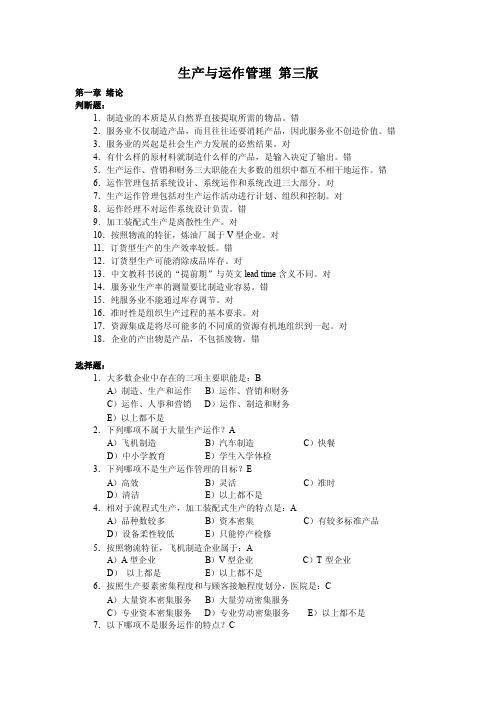
生产与运作管理第三版第一章绪论判断题:1.制造业的本质是从自然界直接提取所需的物品。
错2.服务业不仅制造产品,而且往往还要消耗产品,因此服务业不创造价值。
错3.服务业的兴起是社会生产力发展的必然结果。
对4.有什么样的原材料就制造什么样的产品,是输入决定了输出。
错5.生产运作、营销和财务三大职能在大多数的组织中都互不相干地运作。
错6.运作管理包括系统设计、系统运作和系统改进三大部分。
对7.生产运作管理包括对生产运作活动进行计划、组织和控制。
对8.运作经理不对运作系统设计负责。
错9.加工装配式生产是离散性生产。
对10.按照物流的特征,炼油厂属于V型企业。
对11.订货型生产的生产效率较低。
错12.订货型生产可能消除成品库存。
对13.中文教科书说的“提前期”与英文lead time含义不同。
对14.服务业生产率的测量要比制造业容易。
错15.纯服务业不能通过库存调节。
对16.准时性是组织生产过程的基本要求。
对17.资源集成是将尽可能多的不同质的资源有机地组织到一起。
对18.企业的产出物是产品,不包括废物。
错选择题:1.大多数企业中存在的三项主要职能是:BA)制造、生产和运作B)运作、营销和财务C)运作、人事和营销D)运作、制造和财务E)以上都不是2.下列哪项不属于大量生产运作?AA)飞机制造B)汽车制造C)快餐D)中小学教育E)学生入学体检3.下列哪项不是生产运作管理的目标?EA)高效B)灵活C)准时D)清洁E)以上都不是4.相对于流程式生产,加工装配式生产的特点是:AA)品种数较多B)资本密集C)有较多标准产品D)设备柔性较低E)只能停产检修5.按照物流特征,飞机制造企业属于:AA)A型企业B)V型企业C)T型企业D)以上都是E)以上都不是6.按照生产要素密集程度和与顾客接触程度划分,医院是:CA)大量资本密集服务B)大量劳动密集服务C)专业资本密集服务D)专业劳动密集服务E)以上都不是7.以下哪项不是服务运作的特点?CA)生产率难以确定B)质量标准难以建立C)服务过程可以与消费过程分离D)纯服务不能通过库存调节E)与顾客接触8.当供不应求时,会出现下述情况:DA)供方之间竞争激化B)价格下跌C)出现回扣现象D)质量和服务水平下降E)产量减少第二章企业战略和运作策略判断题:1.当价格是影响需求的主要因素时,就出现了基于成本的竞争。
- 1、下载文档前请自行甄别文档内容的完整性,平台不提供额外的编辑、内容补充、找答案等附加服务。
- 2、"仅部分预览"的文档,不可在线预览部分如存在完整性等问题,可反馈申请退款(可完整预览的文档不适用该条件!)。
- 3、如文档侵犯您的权益,请联系客服反馈,我们会尽快为您处理(人工客服工作时间:9:00-18:30)。
Chapter 02 - Competitiveness, Strategy, and Productivity3. (1) (2) (3) (4) (5) (6) (7)Week Output WorkerCost@$12x40OverheadCost @MaterialCost@$6TotalCostMFP(2) ÷ (6)1 30,000 2,880 4,320 2,700 9,9002 33,600 3,360 5,040 2,820 11,2203 32,200 3,360 5,040 2,760 11,1604 35,400 3,840 5,760 2,880 12,480*refer to solved problem #2Multifactor productivity dropped steadily from a high of to about .4. a. Before: 80 ÷ 5 = 16 carts per worker per hour.After: 84 ÷ 4 = 21 carts per worker per hour.b. Before: ($10 x 5 = $50) + $40 = $90; hence 80 ÷ $90 = .89 carts/$1.After: ($10 x 4 = $40) + $50 = $90; hence 84 ÷ $90 = .93 carts/$1.c. Labor productivity increased by % ((21-16)/16).Multifactor productivity increased by % ((./.89).*Machine ProductivityBefore: 80 ÷ 40 = 2 carts/$1.After: 84 ÷ 50 = carts/$1.Productivity increased by -16% (/2)Chapter 03 - Product and Service Design6. Steps for Making Cash Withdrawal from an ATM1. Insert Card: Magnetic Strip Should be Facing Down2. Watch Screen for Instructions3. Select Transaction Options:1) Deposit2) Withdrawal3) Transfer4) Other4. Enter Information:1) PIN Number2) Select a Transaction and Account3) Enter Amount of Transaction5. Deposit/Withdrawal: 1) Deposit —place in an envelope (which you’ll find near or in the ATM) andinsert it into the deposit slot2) Withdrawal —lift the “Withdrawal Door,” being careful to remove all cash6. Remove card and receipt (which serves as the transaction record)8.Chapter 04 - Strategic Capacity Planning for Products and Services2. %80capacityEffective outputActual Efficiency ==Actual output = .8 (Effective capacity) Effective capacity = .5 (Design capacity) Actual output = (.5)(.8)(Effective capacity) Actual output = (.4)(Design capacity) Actual output = 8 jobs Utilization = .4capacityDesign outputActual =n Utilizatiojobs 204.8capacity Effective output Actual Capacity Design ===10. a. Given: 10 hrs. or 600 min. of operating time per day.250 days x 600 min. = 150,000 min. per year operating time.Total processing time by machineProductABC 1 48,000 64,000 32,000 2 48,000 48,000 36,000 3 30,000 36,000 24,000 460,000 60,000 30,000 Total 186,000208,000122,000machine181.000,150000,122machine 238.1000,150000,208machine224.1000,150000,186≈==≈==≈==C B A N N NYou would have to buy two “A” machines at a total cost of $80,000, or two “B” machines at a total cost of $60,000, or one “C” machine at $80,000.b.Total cost for each type of machine:A (2): 186,000 min ÷ 60 = 3,100 hrs. x $10 = $31,000 + $80,000 = $111,000B (2) : 208,000 ÷ 60 = 3, hrs. x $11 = $38,133 + $60,000 = $98,133 C(1): 122,000 ÷ 60 = 2, hrs. x $12 = $24,400 + $80,000 = $104,400Buy 2 Bs —these have the lowest total cost.Chapter 05 - Process Selection and Facility Layout3.Desired output = 4Operating time = 56 minutesunit per minutes 14hourper units 4hourper minutes 65output Desired time Operating CT ===Task # of Following tasksPositional WeightA 4 23B 3 20C 2 18D 3 25E 2 18F 4 29G 3 24H 1 14 I5a. First rule: most followers. Second rule: largest positional weight.Assembly Line Balancing Table (CT = 14)b. First rule: Largest positional weight.Assembly Line Balancing Table (CT = 14)c. %36.805645stations of no. x CT time Total Efficiency ===4. a. l.2. Minimum Ct = minutesTask Following tasksa 4b 3c 3d 2e 3f 2g 1h3. percent 54.11)3.1(46.CT x N time)(idle percent Idle ==∑=4. 420 min./day 323.1 ( 323)/1.3 min./OT Output rounds to copiers day CT cycle=== b. 1. inutes m 3.224.6N time Total CT ,6.4 time Total ==== 2. Assign a, b, c, d, and e to station 1: minutes [no idle time]Assign f, g, and h to station 2: minutes3. 420182.6 copiers /2.3OT Output day CT ===4.420 min./dayMaximum Ct is 4.6. Output 91.30 copiers /4.6 min./day cycle==7.Chapter 06 - Work Design and Measurement3. Element PR OT NT AF jobST1 .90 .46 .414 .4762 .853 .83 .913 4Total8. A = 24 + 10 + 14 = 48 minutes per 4 hours.min 125.720.11x70.5ST .min 70.5)95(.6NT 20.24048A =-=====9. a. Element PR OT NT A ST12 .83 .9553.56.588.676b.01.A 00.2z 034.s 83.x ==== 222(.034)67.12~68.01(.83)zs n observations ax ⎛⎫⎛⎫===⎪ ⎪⎝⎭⎝⎭c. e = .01 minutes 47 to round ,24.4601.)034(.2e zs n 22=⎪⎭⎫⎝⎛=⎪⎭⎫ ⎝⎛=Chapter 07- Location Planning and Analysis1. Factor Local bank Steel mill Food warehouse Public school1. Convenience forcustomers H L M–H M–H2. Attractiveness ofbuilding H L M M–H3. Nearness to rawmaterials L H L M4. Large amounts ofpower L H L L5. Pollution controls L H L L6. Labor cost andavailability L M L L7. Transportationcosts L M–H M–H M8. Constructioncosts M H M M–HLocation (a) Location (b)4. Factor A B C Weight A B C1. Business Services 9 5 5 2/9 18/9 10/9 10/92. Community Services 7 6 7 1/9 7/9 6/9 7/93. Real Estate Cost 3 8 7 1/9 3/9 8/9 7/94. Construction Costs 5 6 5 2/9 10/9 12/9 10/95. Cost of Living 4 7 8 1/9 4/9 7/9 8/96. Taxes 5 5 5 1/9 5/9 5/9 4/97. Transportation 6 7 8 1/9 6/9 7/9 8/9Total 39 44 45 53/9 55/9 54/9 Each factor has a weight of 1/7.a. Composite Scores 39 44 45 7 7 7B orC is the best and A is least desirable.b. Business Services and Construction Costs both have a weight of 2/9; the other factors eachhave a weight of 1/9.5 x + 2 x + 2 x = 1 x = 1/9c. Composite ScoresA B C 53/9 55/9 54/9B is the best followed byC and then A.5.Locationx yA 3 7B 8 2C 4 6D 4 1E 6 4Totals 25 20-x =∑x i= 25 = -y =∑y i= 20 = n 5 n 5Hence, the center of gravity is at (5,4) and therefore the optimal location.Chapter 08 - Management of Quality1. ChecksheetWork Type FrequencyLube and Oil 12Brakes 7Tires 6Battery 4Transmission 1Total 30ParetoLube & Oil Brakes Tires Battery Trans.2 .The run charts seems to show a pattern of errors possibly linked to break times or the end of the shift. Perhaps workers are becoming fatigued. If so, perhaps two 10 minute breaks in the morning and again in the afternoon instead of one 20 minute break could reduce some errors. Also, errors are occurring during the last few minutes before noon and the end of the shift, and those periods should also be given management’s attention.4break lunch break3 2 1 0• • •• • • ••• • • ••••••• ••• •• • •• • •••Chapter 9 - Quality Control4. Sample Mean Range1Mean Chart: =X ± A 2-R = ± 2 = ±3UCL = , LCL =4 Range Chart: UCL = D 4-R = = 5LCL = D 3-R = 0 = 06[Both charts suggest the process is in control: Neither has any points outside the limits.]6. n = 200 Control Limits = np p p )1(2-±Thus, UCL is .0234 and LCL becomes 0.Since n = 200, the fraction represented by each data point is half the amount shown. ., 1 defective = .005, 2 defectives = .01, etc.Sample 10 is too large.7. 857.714110c ==Control limits: 409.8857.7c 3c ±=± UCL is , LCL becomes 0.All values are within the limits.14. Let USL = Upper Specification Limit, LSL = Lower Specification Limit,X = Process mean, σ = Process standard deviationFor process H:}{capablenot ,0.193.93.04.1 ,938.min 04.1)32)(.3(1516393.)32)(.3(1.14153<===-=σ-=-=σ-pk C X USL LSL X 0096.)200(1325==p 0138.0096.200)9904(.0096.20096.±=±=For process K:.1}17.1,0.1min{17.1)1)(3(335.3630.1)1)(3(30333===-=σ-=-=σ- C X USL LSL X pk Assuming the minimum acceptable pk C is , since < , the process is not capable.For process T:33.1}33.1,67.1min{33.1)4.0)(3(5.181.20367.1)4.0)(3(5.165.183===-=σ-=-=σ- C X USL LSL X pk Since = , the process is capable.Chapter 10 - Aggregate Planning and Master Scheduling7. a.No backlogs are allowedPeriodForecast Output Regular Overtime Subcontract Output - Forecast Inventory Beginning Ending Average Backlog Costs: Regular Overtime Subcontract Inventory Totalb.Level strategyPeriodForecastOutputRegularOvertimeSubcontractOutput - ForecastInventoryBeginningEndingAverageBacklogCosts:RegularOvertimeSubcontractInventoryBacklogTotal8.PeriodForecastOutputRegularOvertimeSubcontractOutput- ForecastInventoryBeginningEndingAverageBacklogCosts:RegularOvertimeSubcontractInventoryBacklogTotalChapter 11 - MRP and ERP1. a. F: 2 G: 1 H: 1J: 2 x 2 = 4 L: 1 x 2 = 2 A: 1 x 4 = 4D: 2 x 4 = 8 J: 1 x 2 = 2 D: 1 x 2 = 2Totals: F = 2; G = 1; H = 1; J = 6; D = 10; L = 2; A = 4b.4.MasterSchedule10. Week 1 2 3 4Material 40 80 60 70Week 1 2 3 4Labor hr. 160 320 240 280Mach. hr. 120 240 180 210a. Capacity utilizationWeek 1 2 3 4Labor % % 80% %Machine 60% 120% 90% 105%b. C apacity utilization exceeds 100% for both labor and machine in week 2, and formachine alone in week 4.Production could be shifted to earlier or later weeks in which capacity isunderutilized. Shifting to an earlier week would result in added carrying costs;shifting to later weeks would mean backorder costs.Another option would be to work overtime. Labor cost would increase due toovertime premium, a probable decrease in productivity, and possible increase inaccidents.Chapter 12 - Inventory Management2. The following table contains figures on the monthly volume and unit costs for a random sample of 16 items for a list of 2,000 inventory items.a. See table.b. To allocate control efforts.c. It might be important for some reason other than dollar usage, such as cost of astockout, usage highly correlated to an A item, etc.3. D = 1,215 bags/yr. S = $10 H = $75a. bags HDS Q 187510)215,1(22===b. Q/2 = 18/2 = 9 bagsc.orders ordersbags bags Q D 5.67/ 18 215,1== d . S QD H 2/Q TC +=350,1$675675)10(18215,1)75(218=+=+=e. Assuming that holding cost per bag increases by $9/bag/yearQ ==84)10)(215,1(217 bags71.428,1$71.714714)10(17215,1)84(217=+=+=TCIncrease by [$1, – $1,350] = $4.D = 40/day x 260 days/yr. = 10,400 packagesS = $60 H = $30a. oxes b 20496.2033060)400,10(2H DS 2Q 0====b. S QD H 2Q TC +=82.118,6$82.058,3060,3)60(204400,10)30(2204=+=+=c. Yesd. )60(200400,10)30(2200TC 200+=TC 200 = 3,000 + 3,120 = $6,1206,120 – 6, (only $ higher than with EOQ, so 200 is acceptable.)7.H = $2/month S = $55D 1 = 100/month (months 1–6)D 2 = 150/month (months 7–12)a. 16.74255)100(2Q :D H DS2Q 010===83.90255)150(2Q :D 02==b. The EOQ model requires this.c. Discount of $10/order is equivalent to S – 10 = $45 (revised ordering cost)1–6 TC74 = $180$)45(150100)2(2150TC 145$)45(100100)2(2100TC *140$)45(50100)2(250TC 15010050=+==+==+=7–12 TC 91 =$195$)45(150150)2(2150TC *5.167$)45(100150)2(2100TC 185$)45(50150)2(250TC 15010050=+==+==+=10. p = 50/ton/day u = 20 tons/day200 days/yr.S = $100 H = $5/ton per yr.a. bags] [10,328 tons 40.5162050505100)000,4(2u p p H DS 2Q 0=-=-=b. ]bags 8.196,6 .approx [ tons 84.309)30(504.516)u p (P Q I max ==-=Average is92.154248.309:2I max =tons [approx. 3,098 bags] c. Run length =days 33.10504.516P Q == d. Runs per year = 8] approx .[ 7.754.516000,4QD == e. Q ' =TC =S QD H 2I max + TC orig. = $1, TC rev. = $Savings would be $D= 20 tons/day x 200 days/yr. = 4,000 tons/yr.15. Range PHQ D = 4,900 seats/yr. 0–999 $ $ 495 H = .4P 1,000–3,999 497 NF S = $50 4,000–5,999 500 NF 6,000+503 NFCompare TC 495 with TC for all lower price breaks:TC 495 =495 ($2) + 4,900($50) + $(4,900) = $25,490 2 495 TC 1,000 = 1,000 ($ + 4,900($50) + $(4,900) = $25,4902 1,000 TC 4,000 = 4,000 ($ + 4,900($50) + $(4,900) = $27,9912 4,000 TC 6,000 = 6,000 ($ + 4,900($50) + $(4,900) = $29,6262 6,000Hence, one would be indifferent between 495 or 1,000 units 22. d = 30 gal./day ROP = 170 gal. LT = 4 days,ss = Z σd LT = 50 gal Risk = 9% Z = Solving, σd LT = 3% Z = , ss= x = gal.Chapter 13 - JIT and Lean Operations1. N = ?N = DT(1 + X)D = 80 pieces per hourC T = 75 min. = hr. = 80 = 3C = 45 45X = .35QuantityTC4. The smallest daily quantity evenly divisible into all four quantities is 3. Therefore, usethree cycles.Product Daily quantity Units per cycleA 21 21/3 = 7B 12 12/3 = 4C 3 3/3 = 1D 15 15/3 = 55.a. Cycle 1 2 3 4A 6 6 5 5B 3 3 3 3C 1 1 1 1D 4 4 5 5E 2 2 2 2 b. Cycle 1 2A 11 11B 6 6C 2 2D 8 8E 4 4c. 4 cycles = lower inventory, more flexibility2 cycles = fewer changeovers7. Net available time = 480 – 75 = 405. Takt time = 405/300 units per day = minutes. Chapter 15 - Scheduling6. a. FCFS: A–B–C–DSPT: D–C–B–AEDD: C–B–D–ACR: A–C–D–BFCFS: Job time Flow time Due date DaysJob (days) (days) (days) tardyA 14 14 20 0B 10 24 16 8C 7 31 15 16D 6 37 17 2037 106 44SPT: Job time Flow time Due date Days Job (days) (days) (days) tardyD 6 6 17 0C 7 13 15 0B 10 23 16 7A 14 37 20 1737 79 24EDD:Job D has the lowest critical ratio therefore it is scheduled next and completed on day 27.b.ardi Flow time Average flow time Number of jobs Days tardy Average job t ness Number of jobs Flow timeAverage number of jobs at the center Makespan==∑=FCFS SPT EDD CRc. SPT is superior.9.Thus, the sequence is b-a-g-e-f-d-c.。
